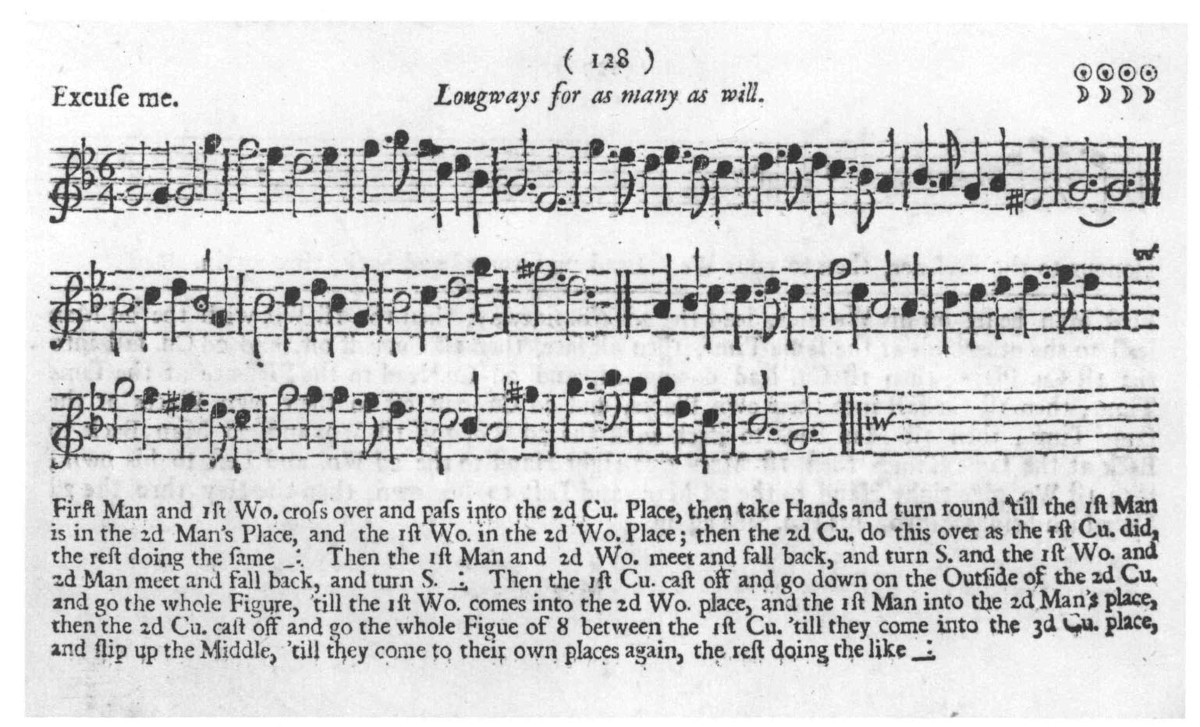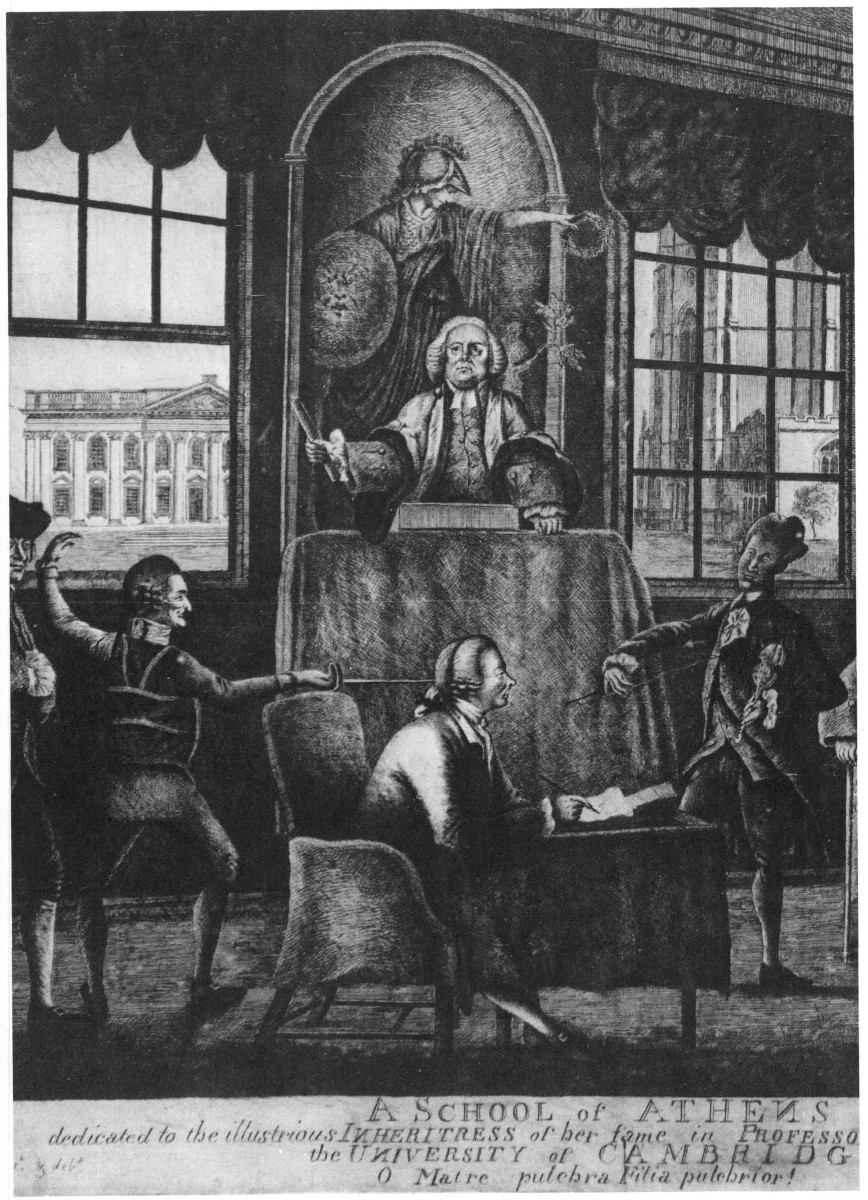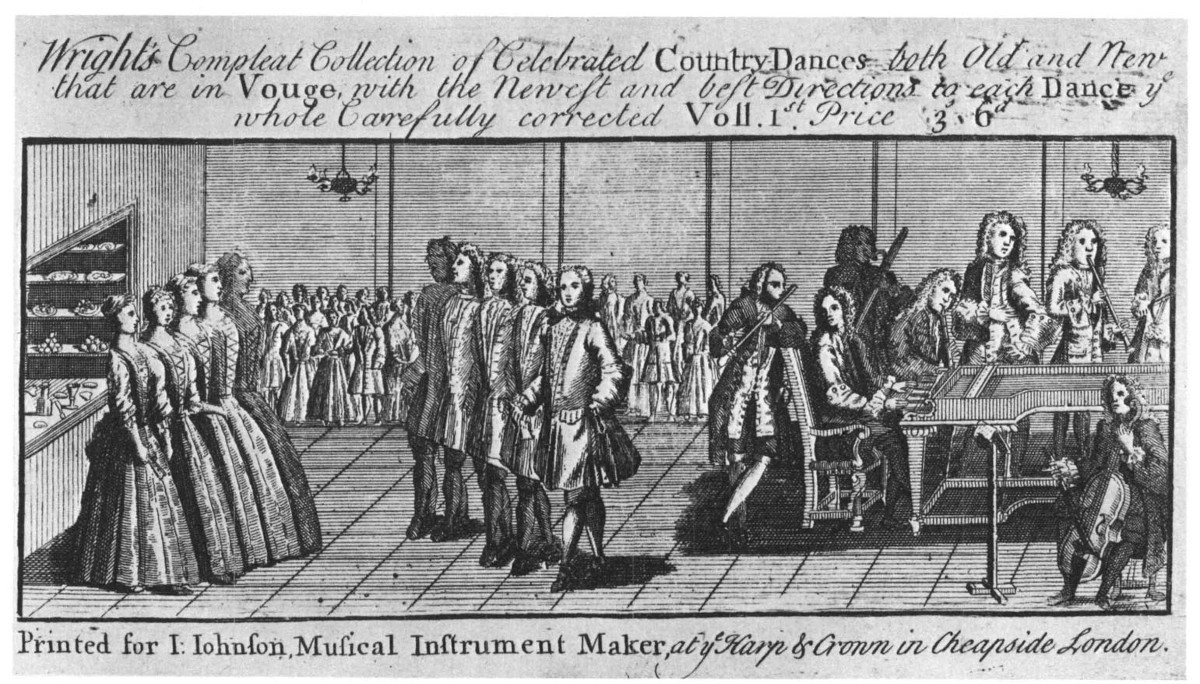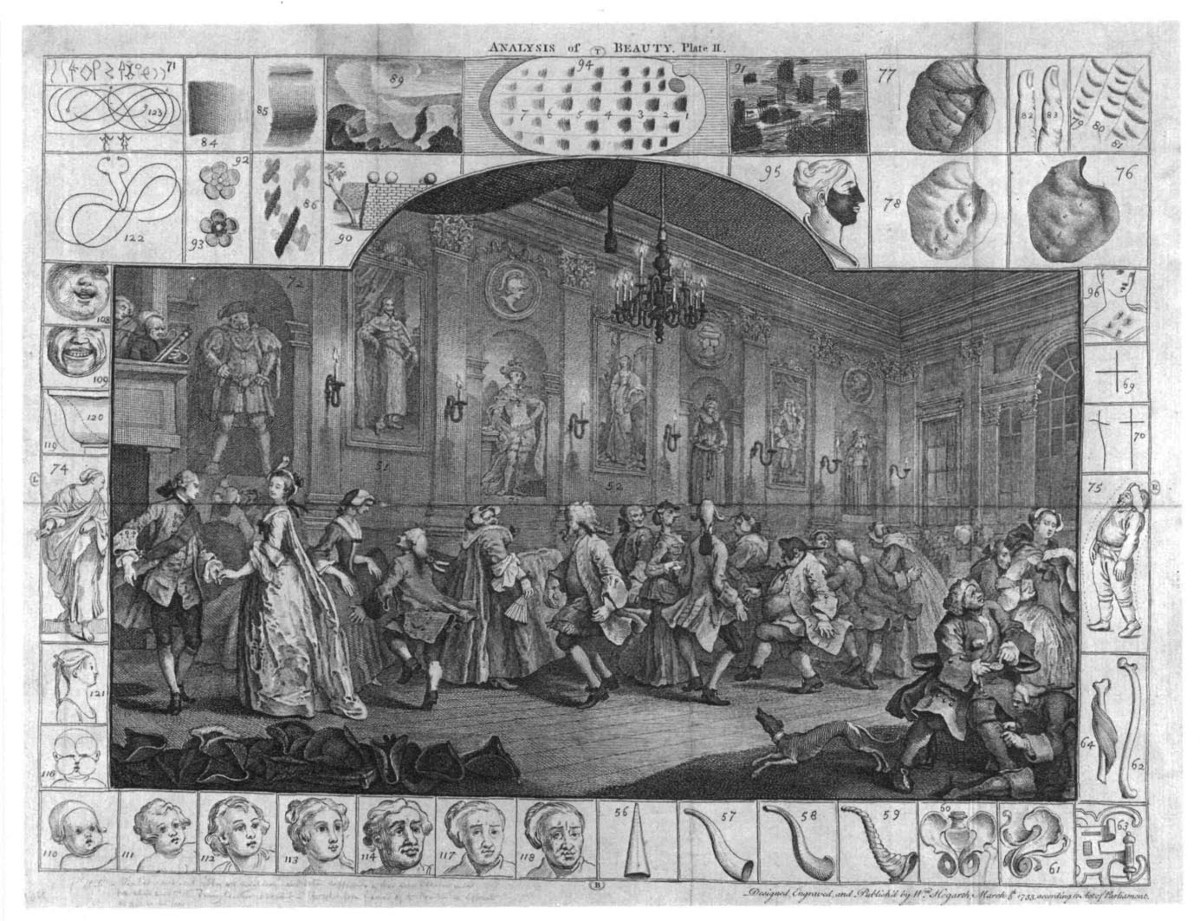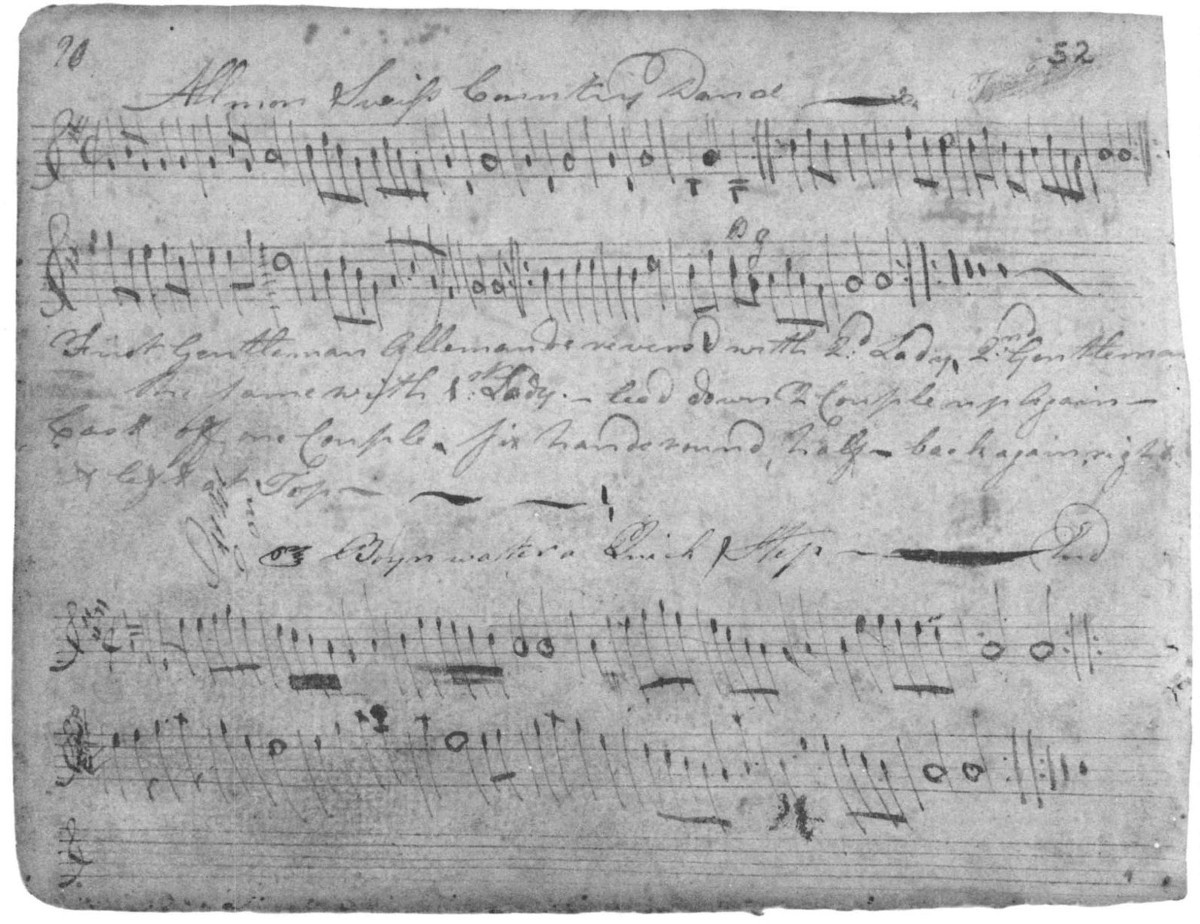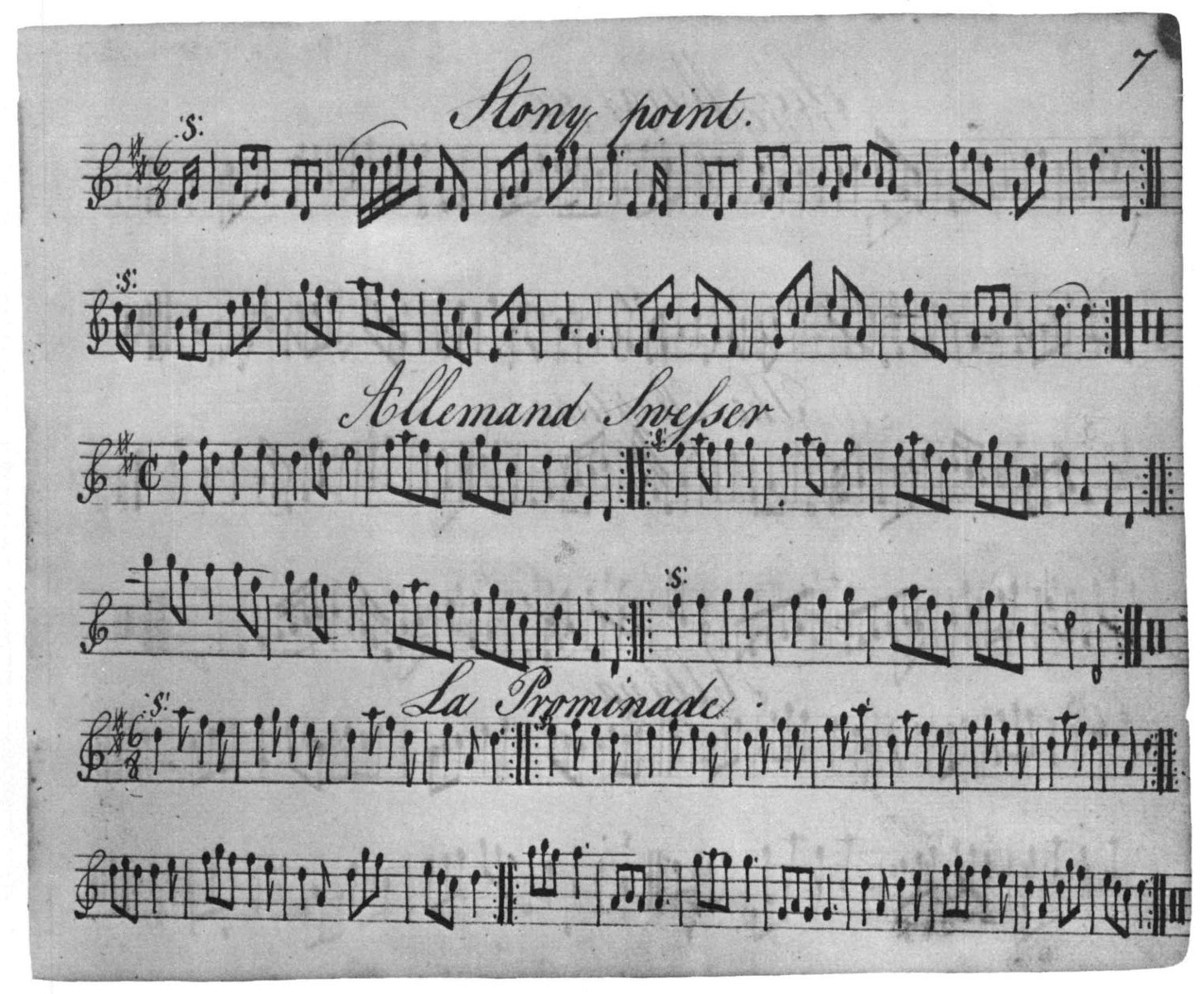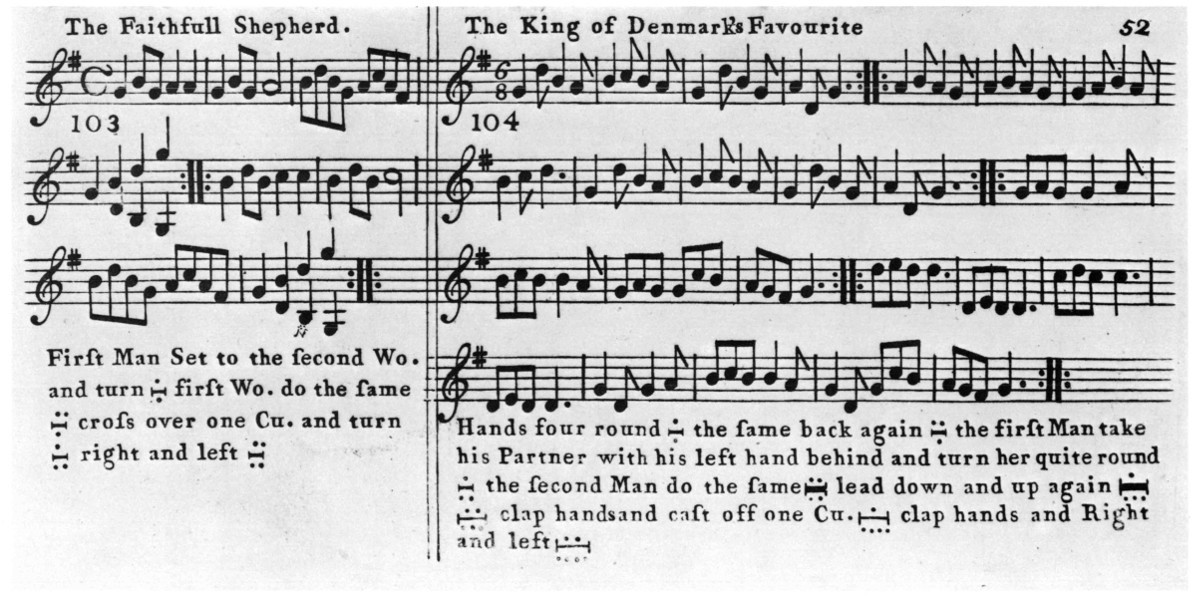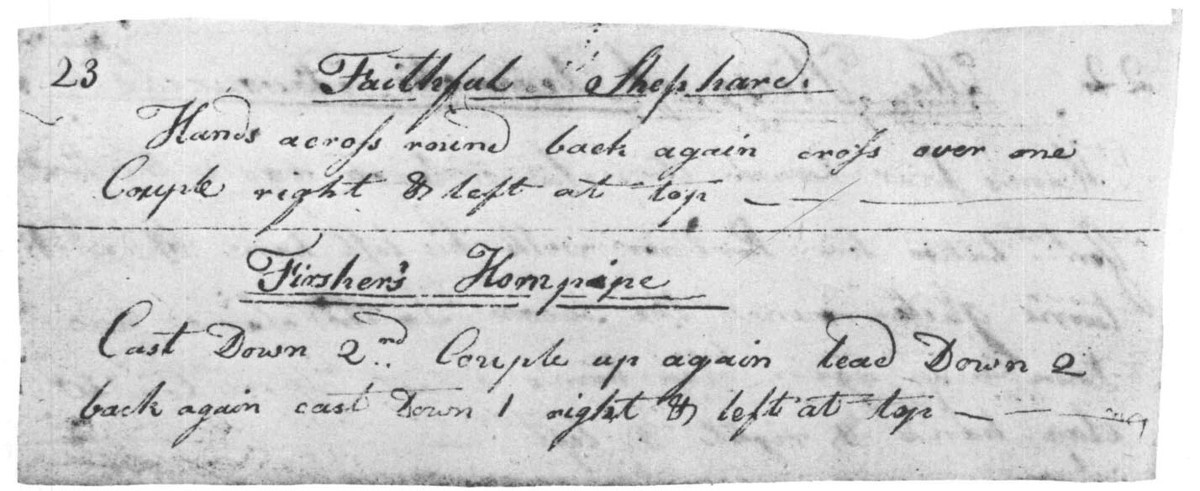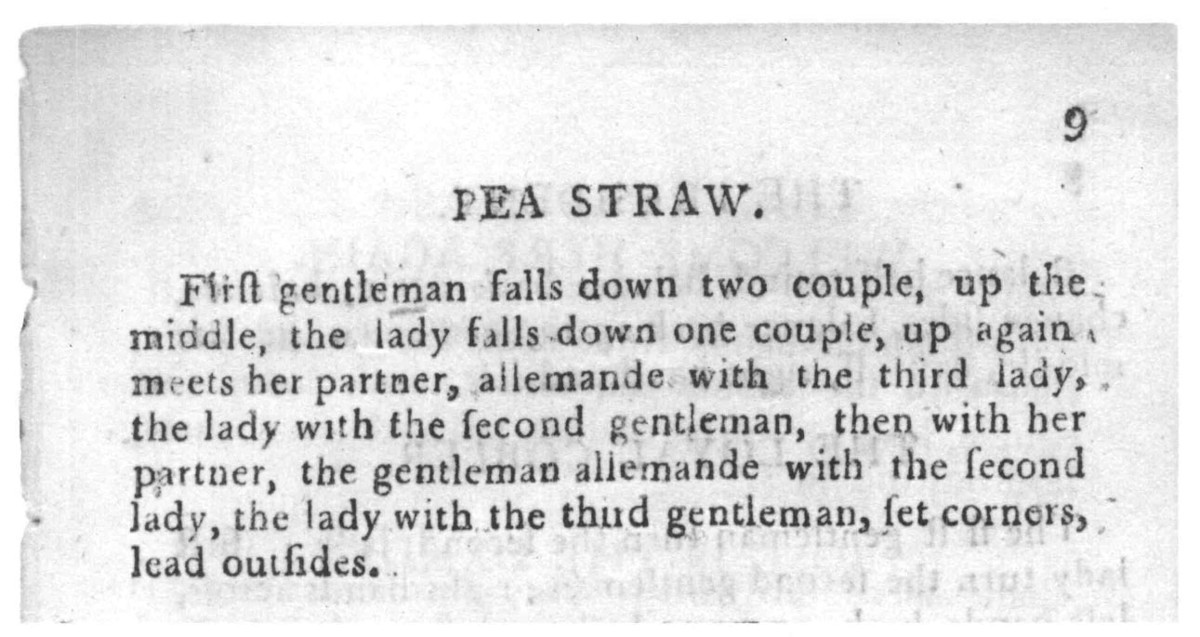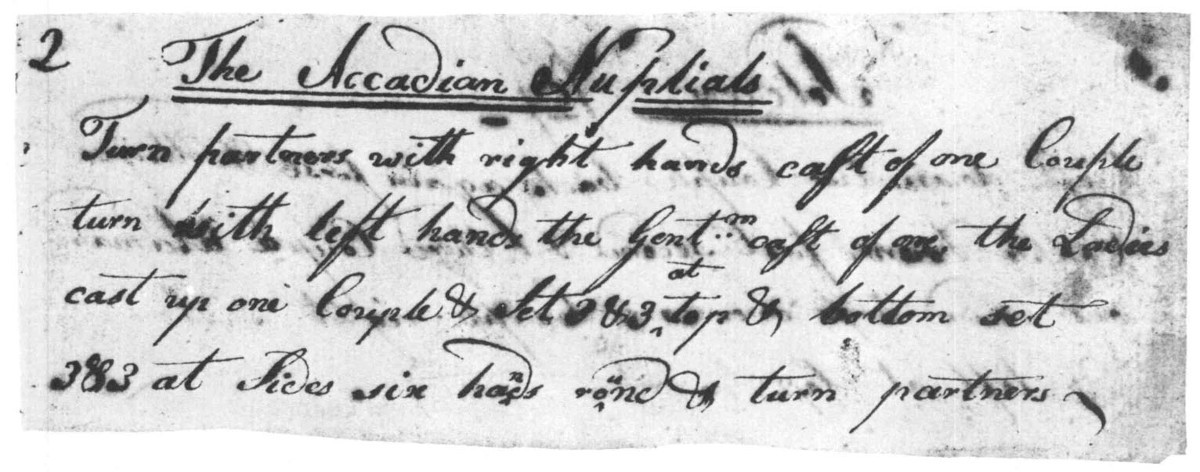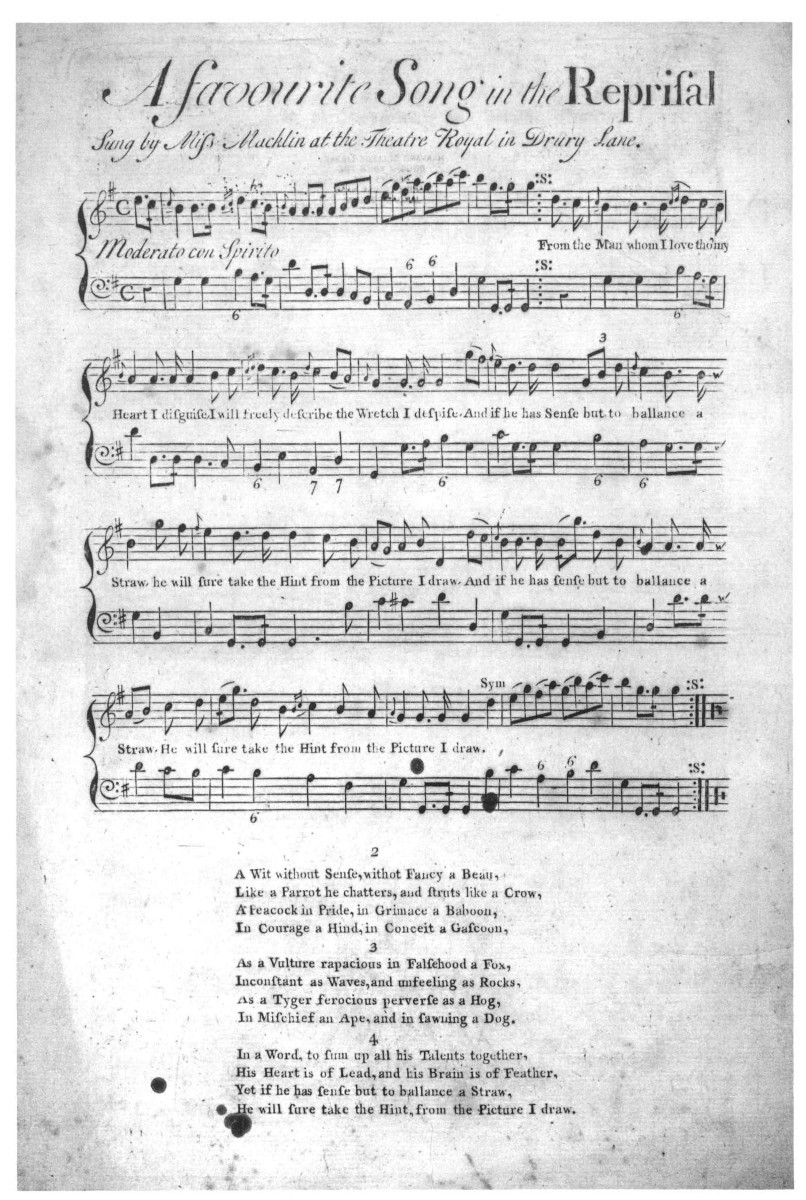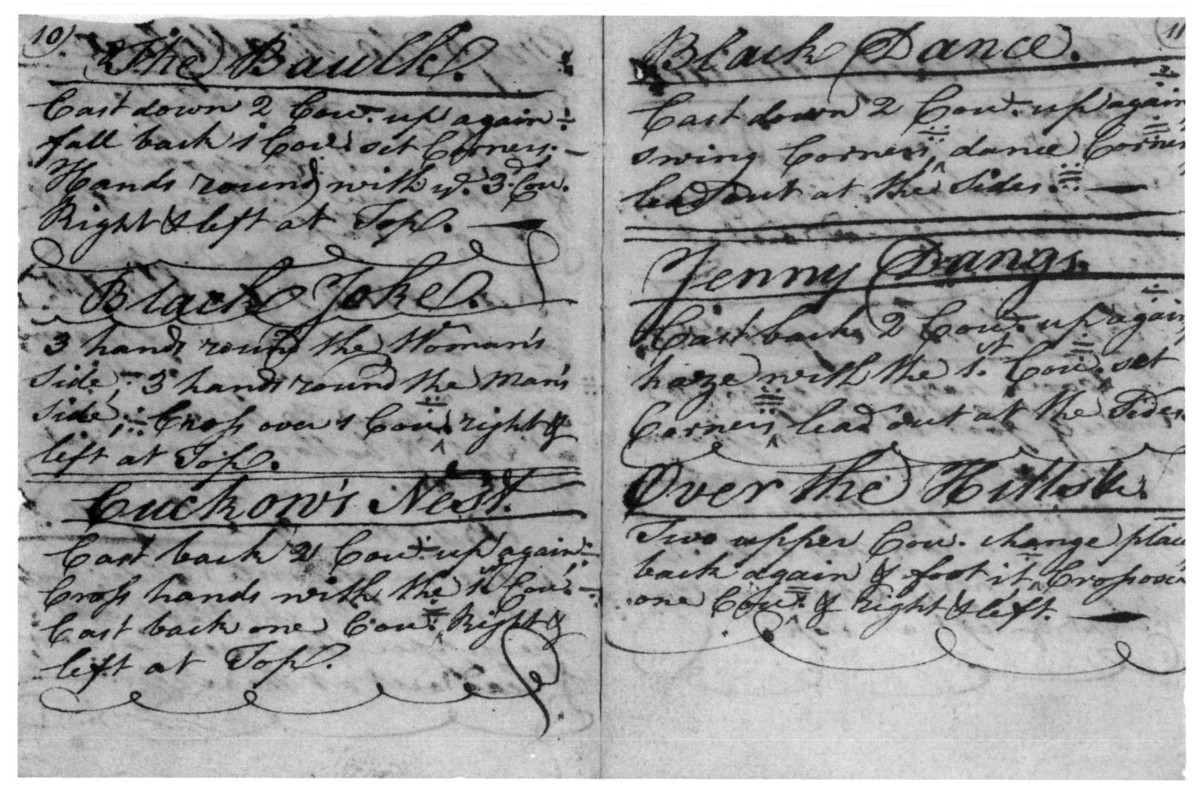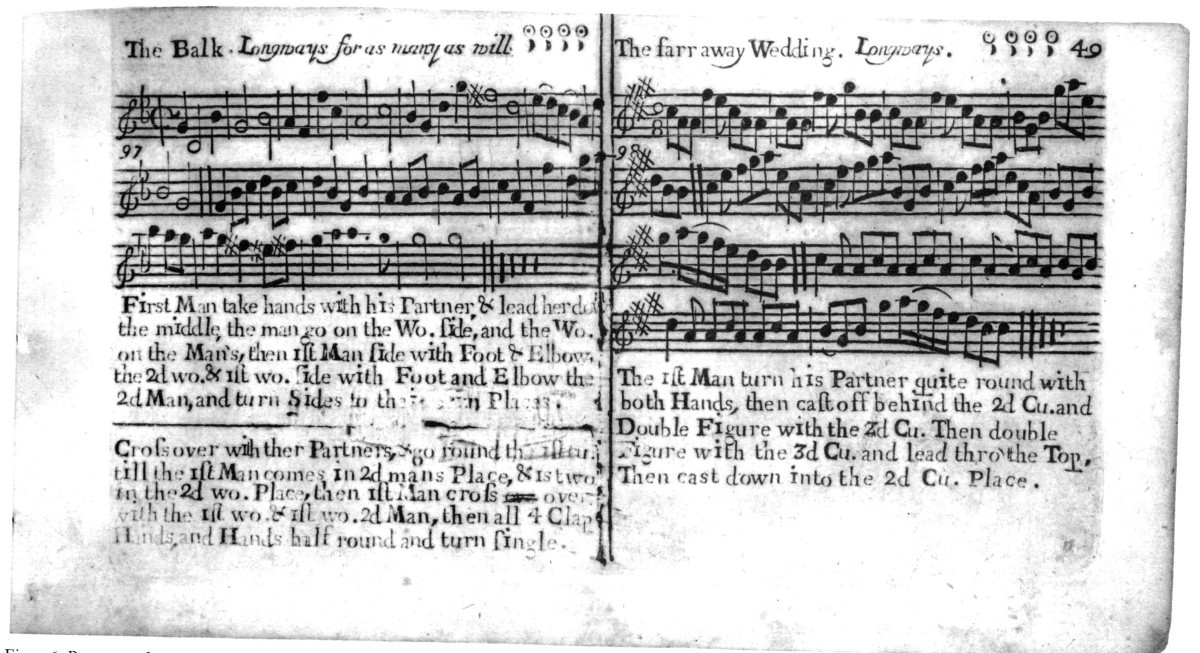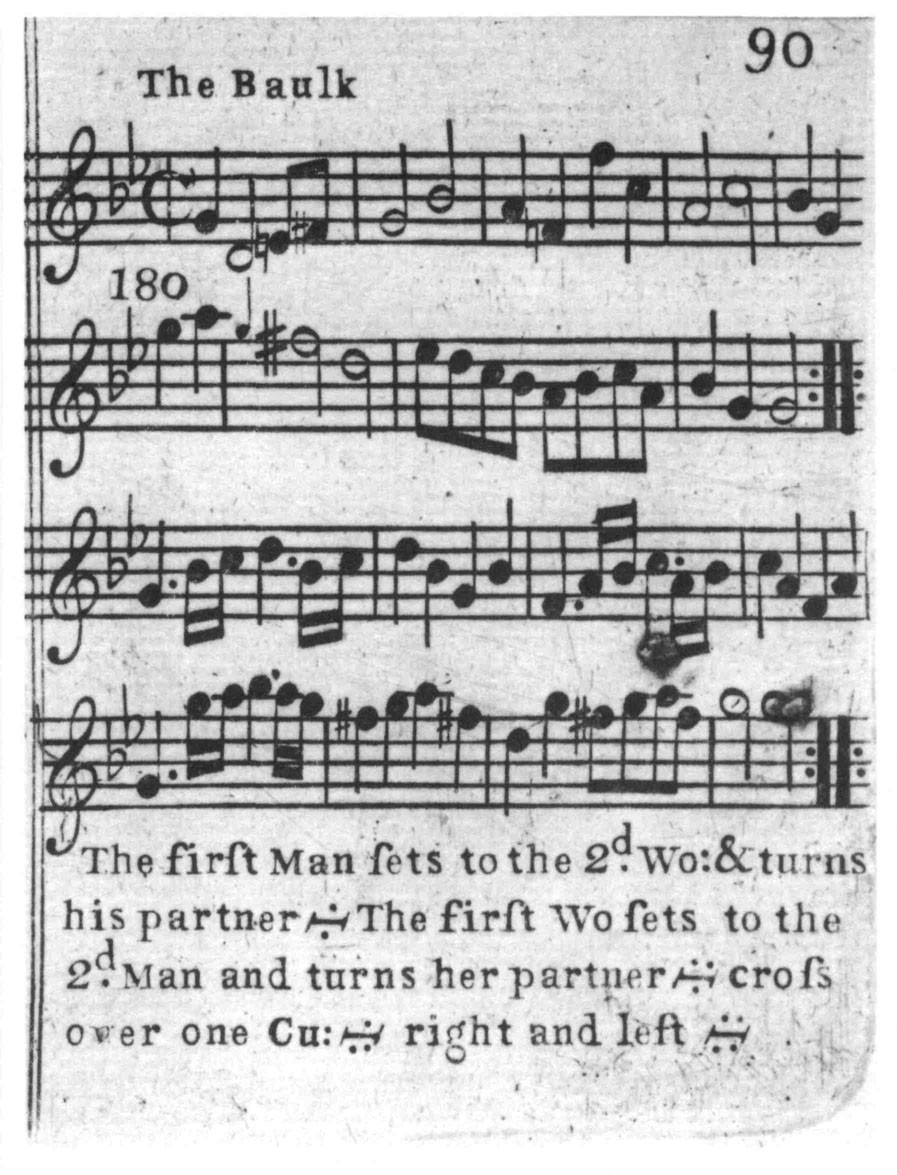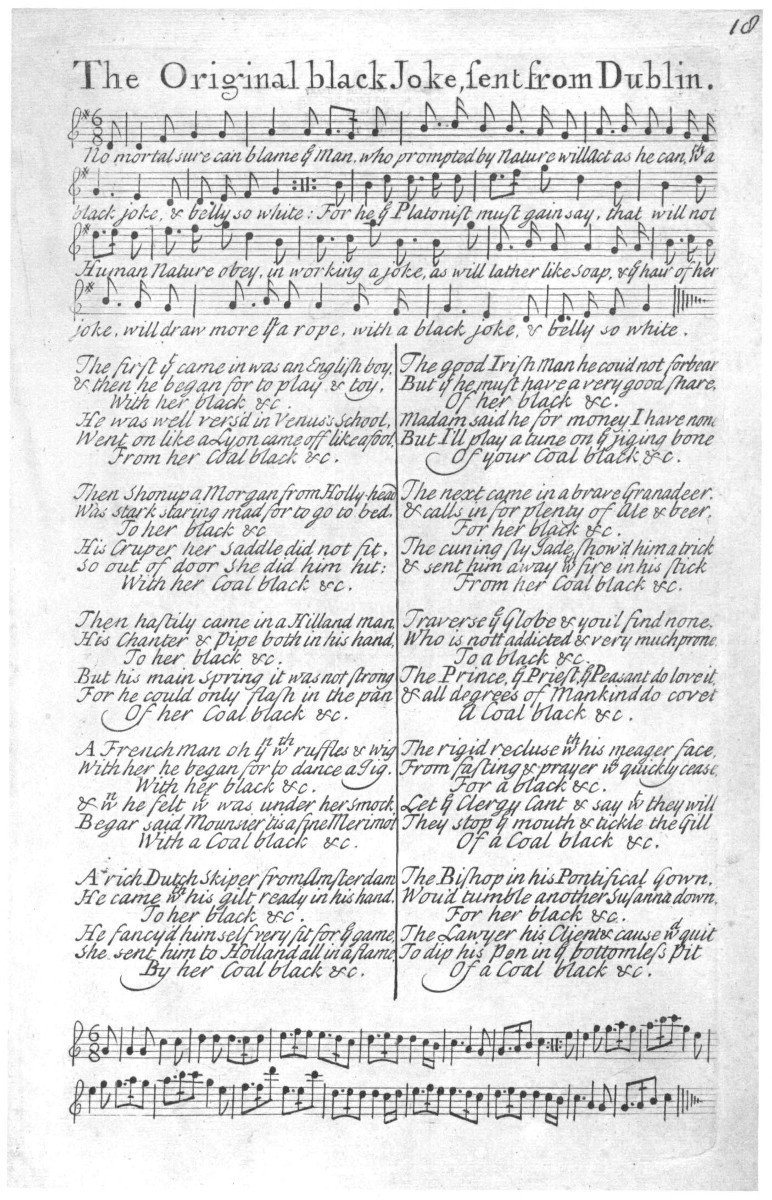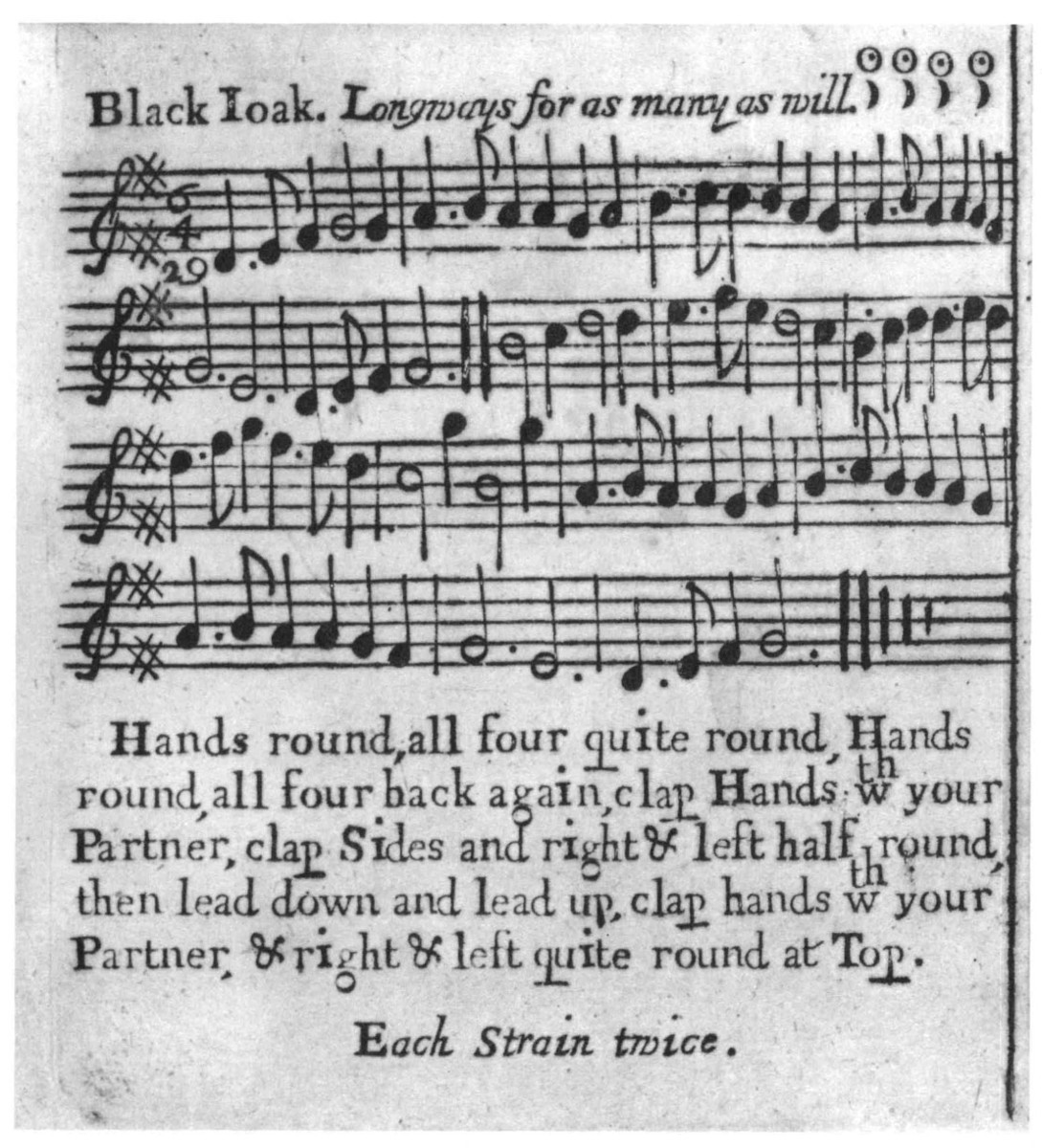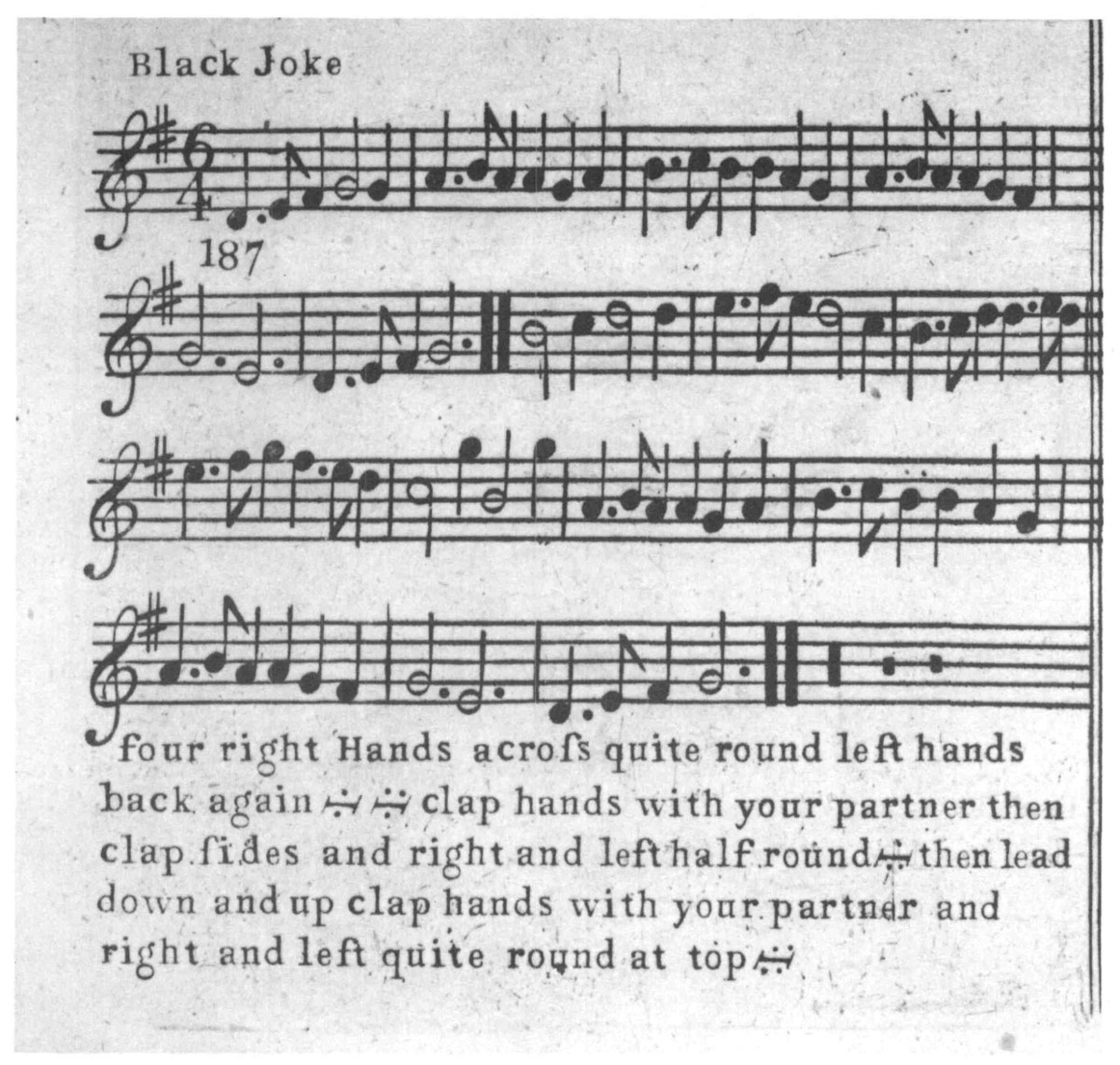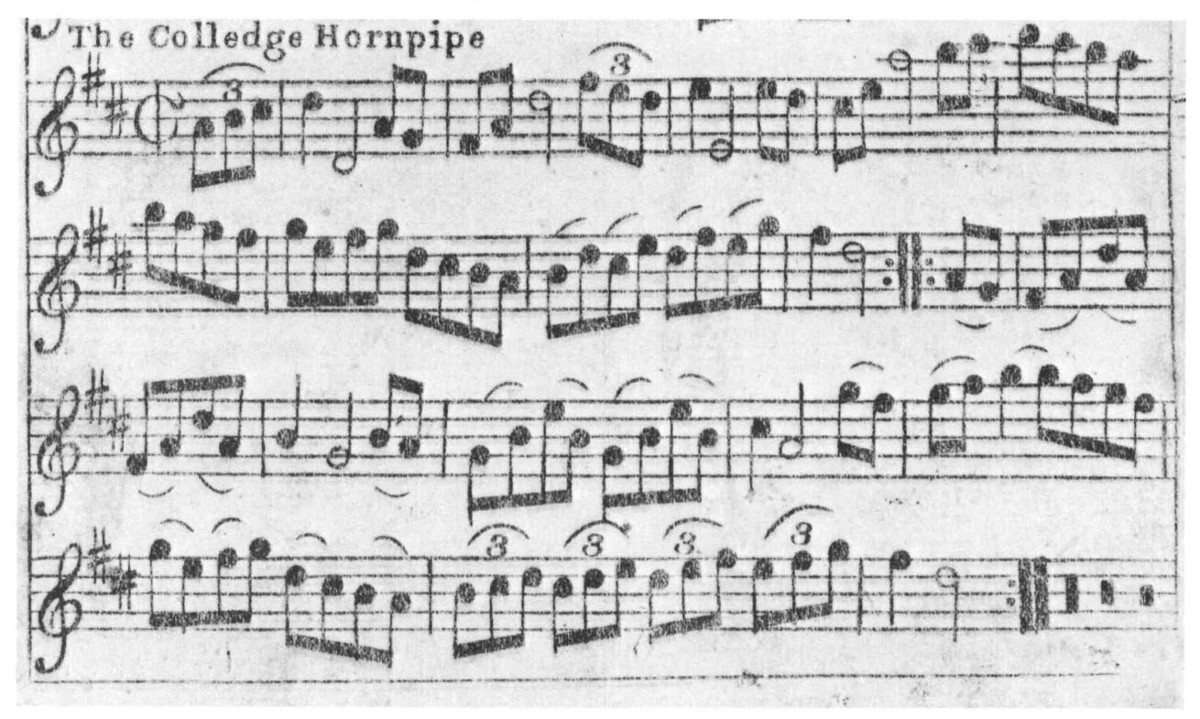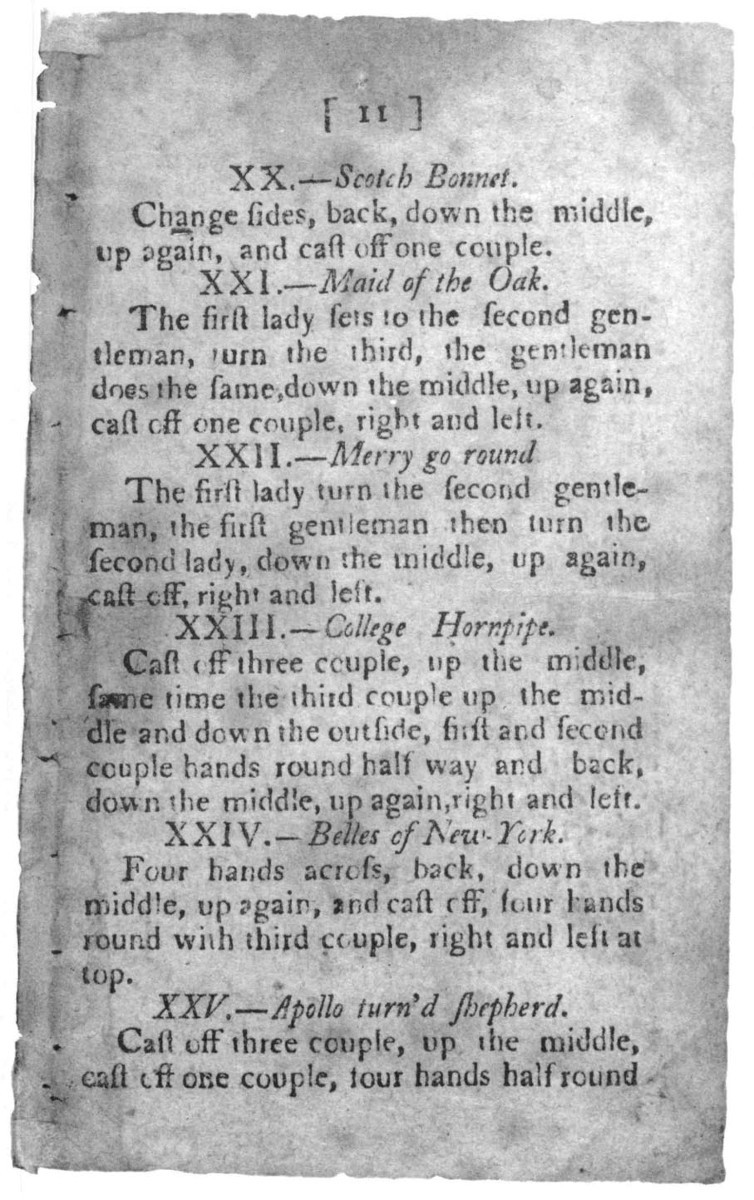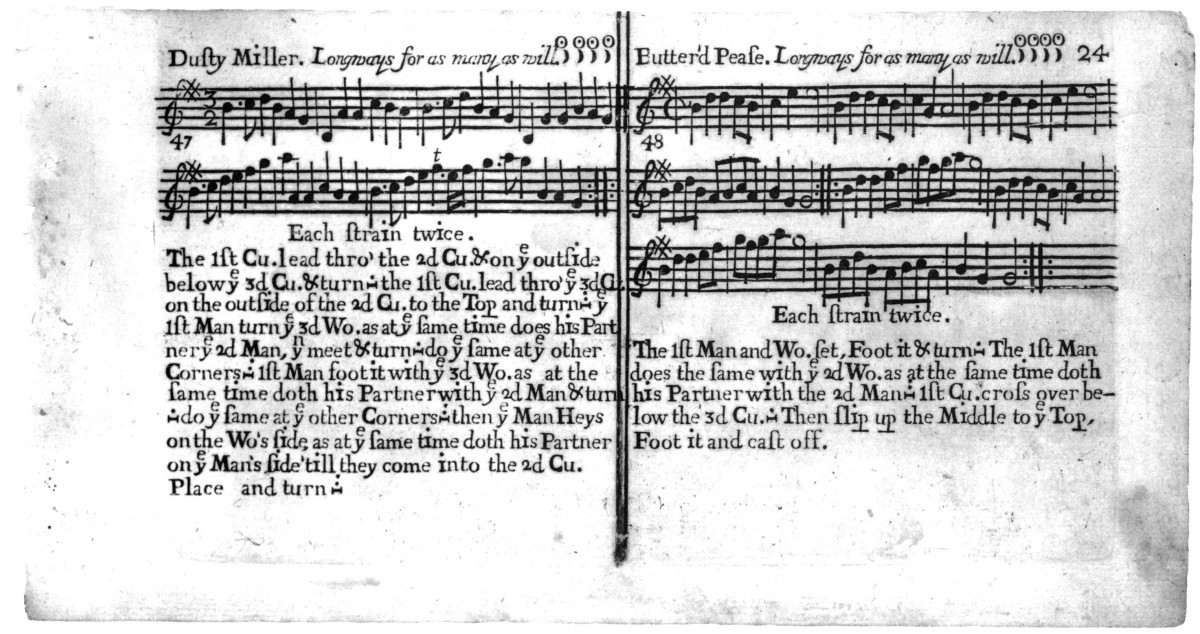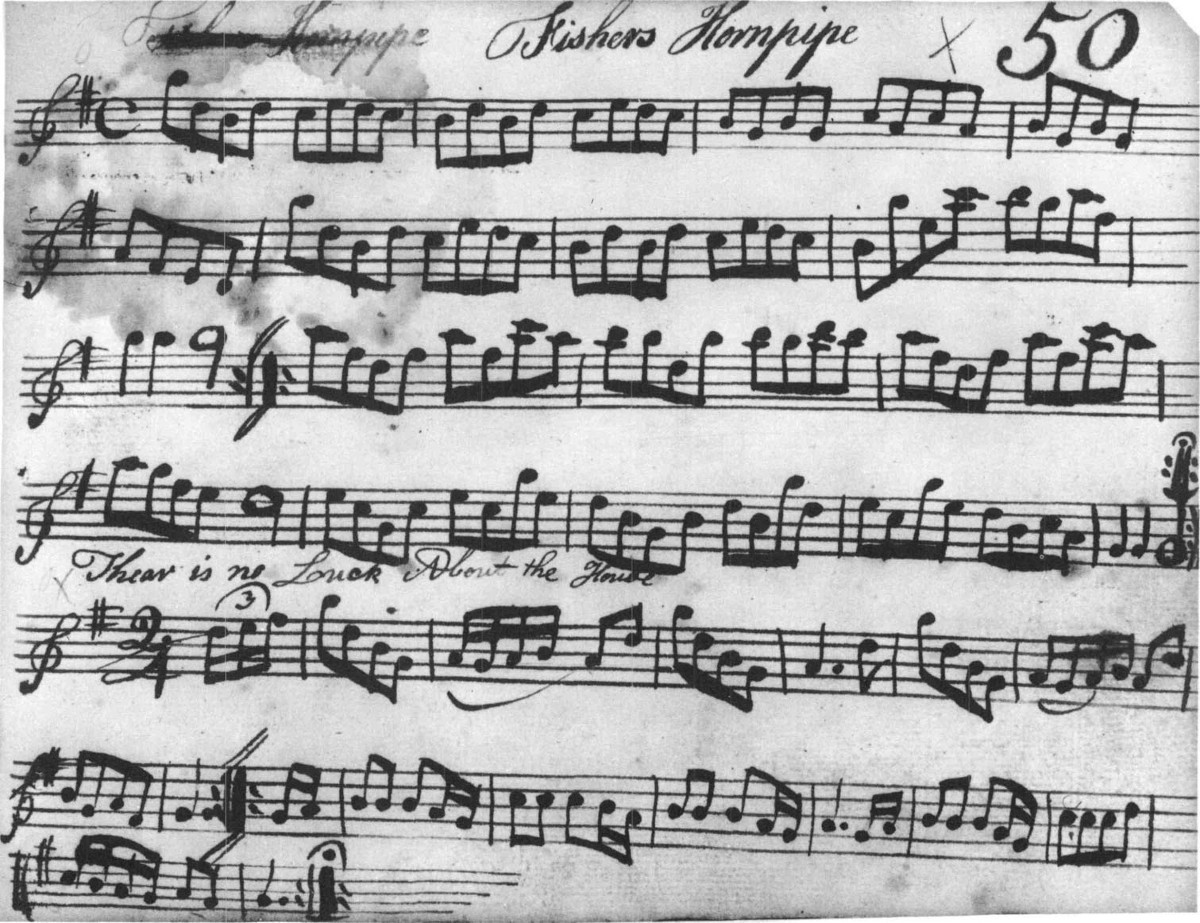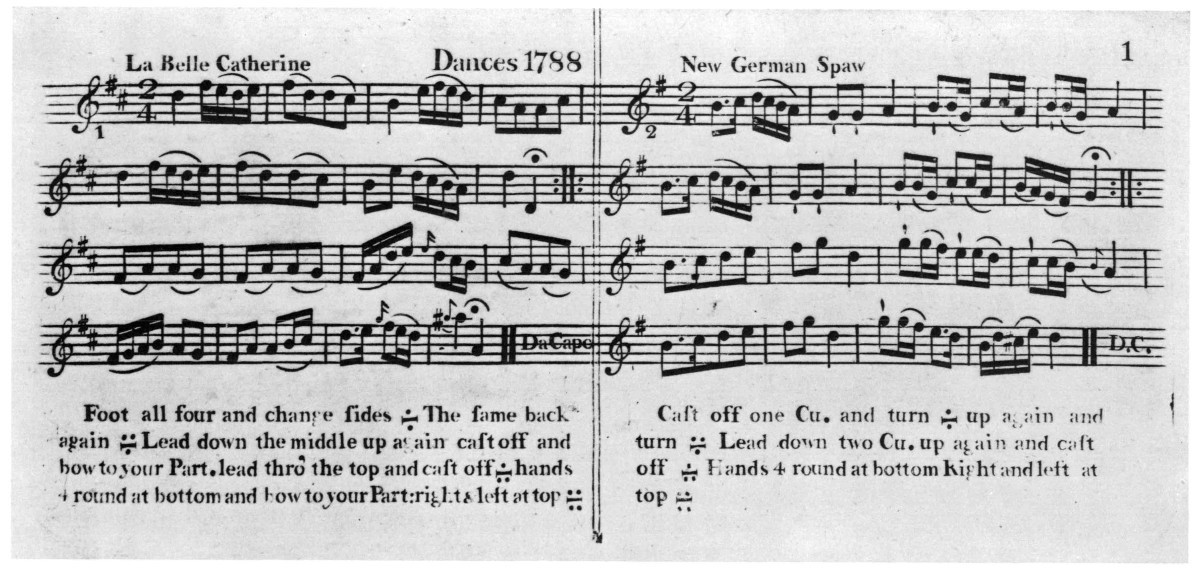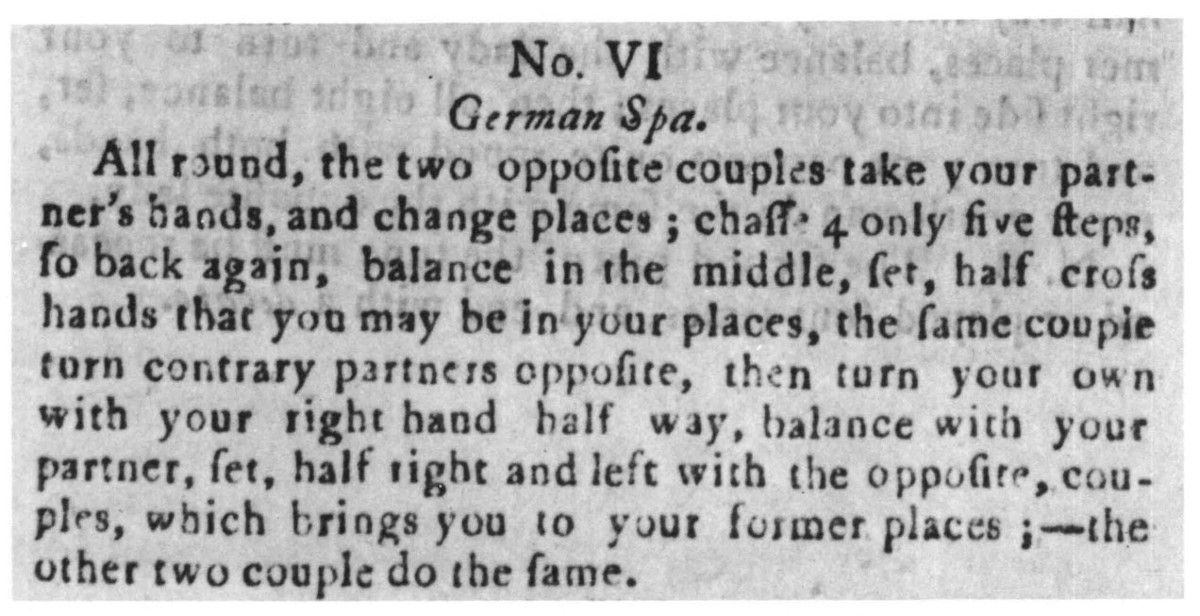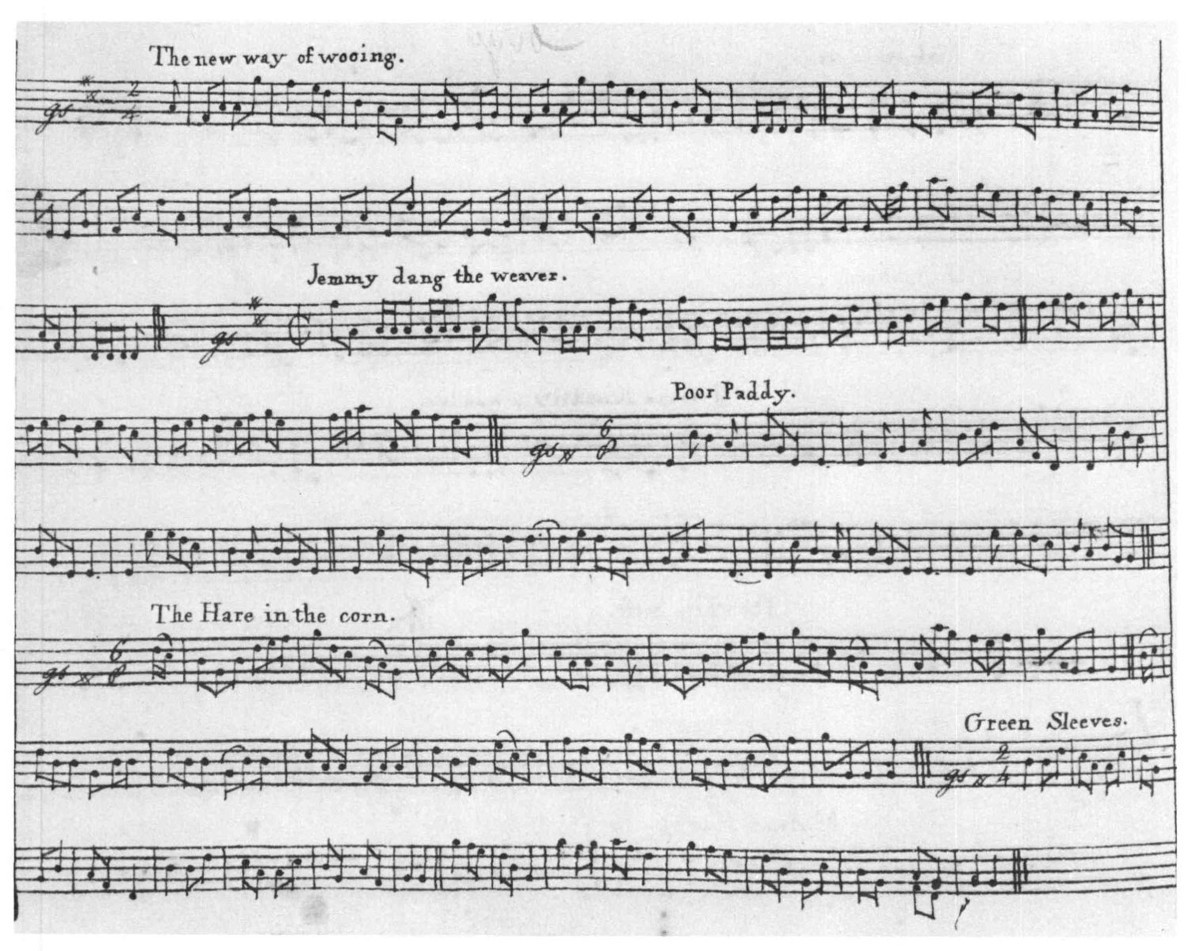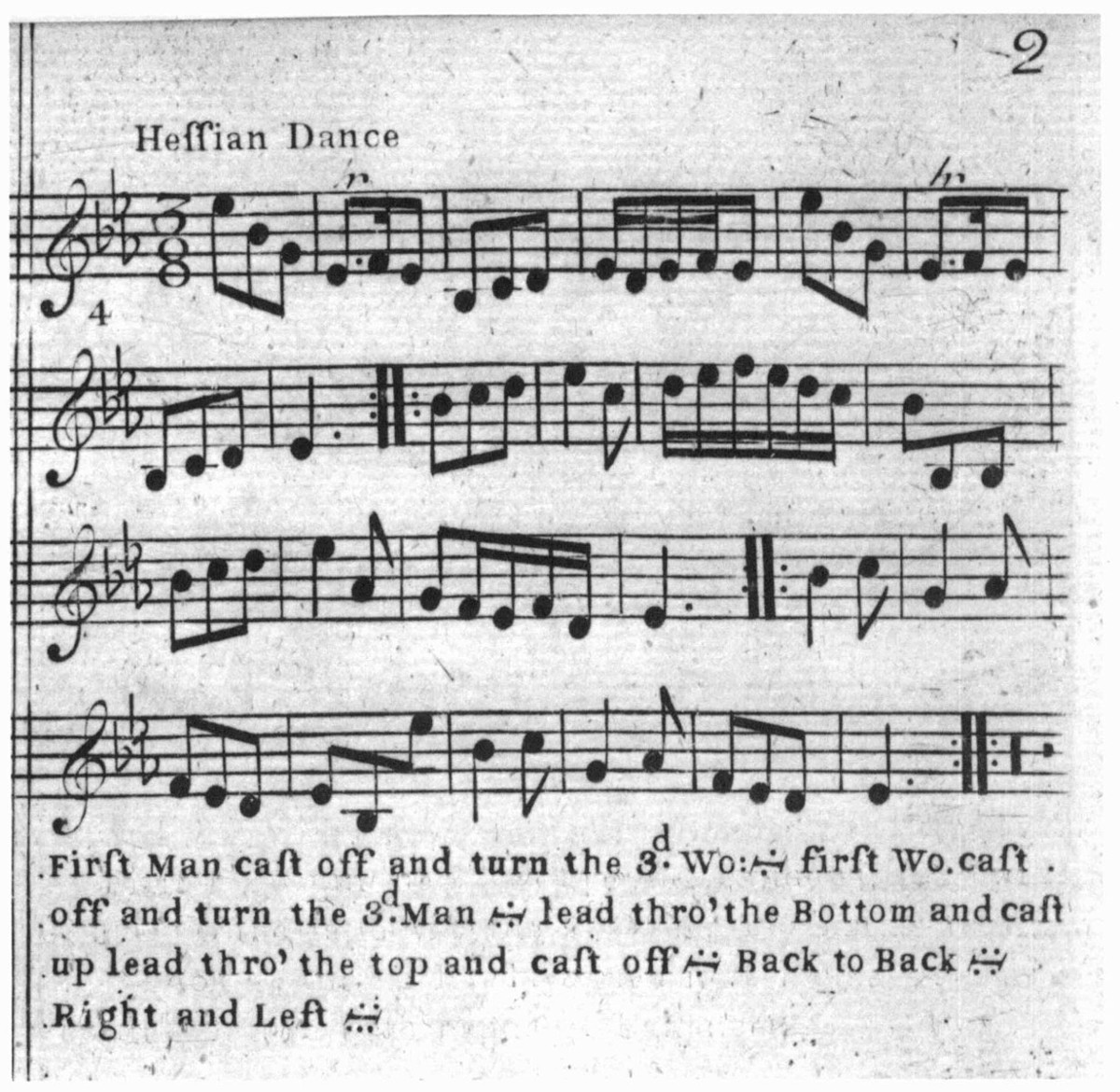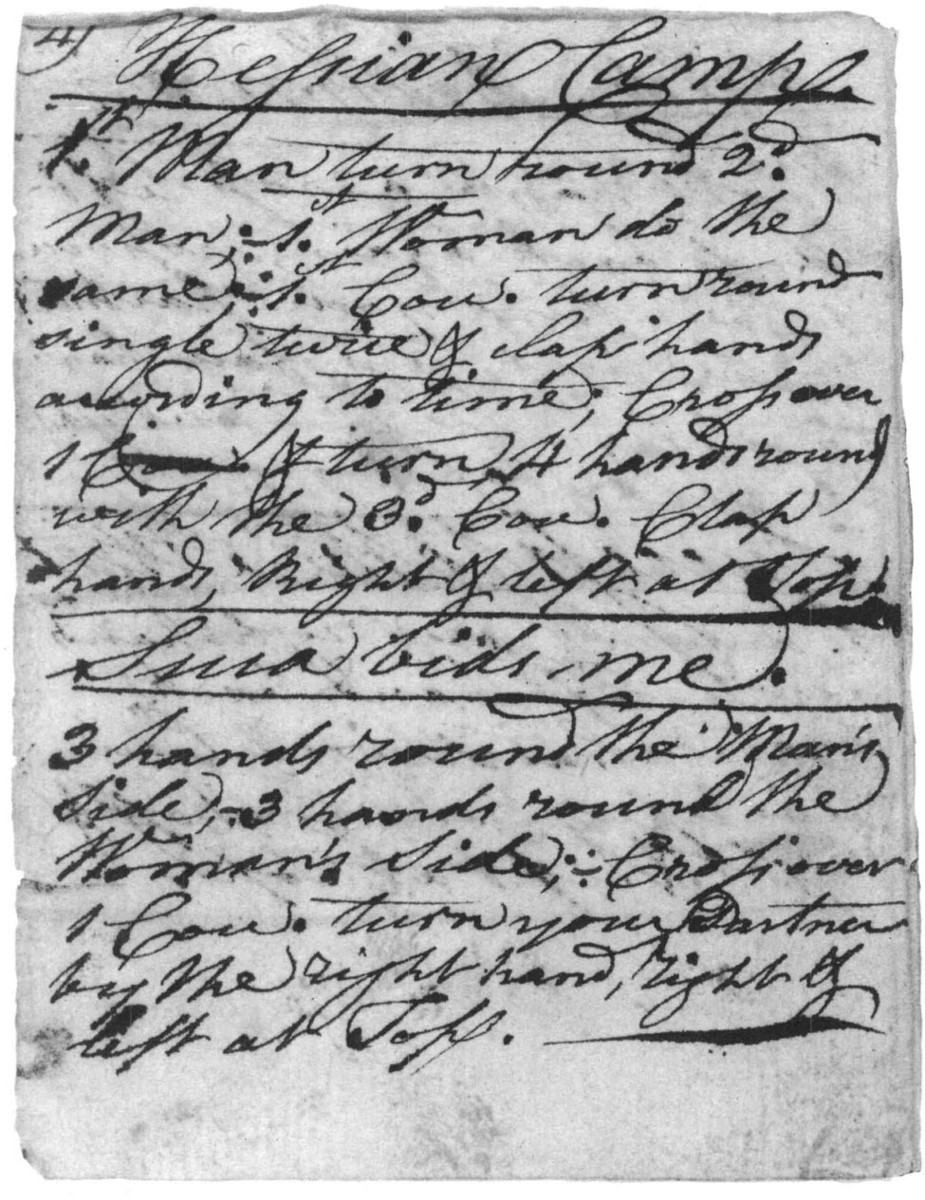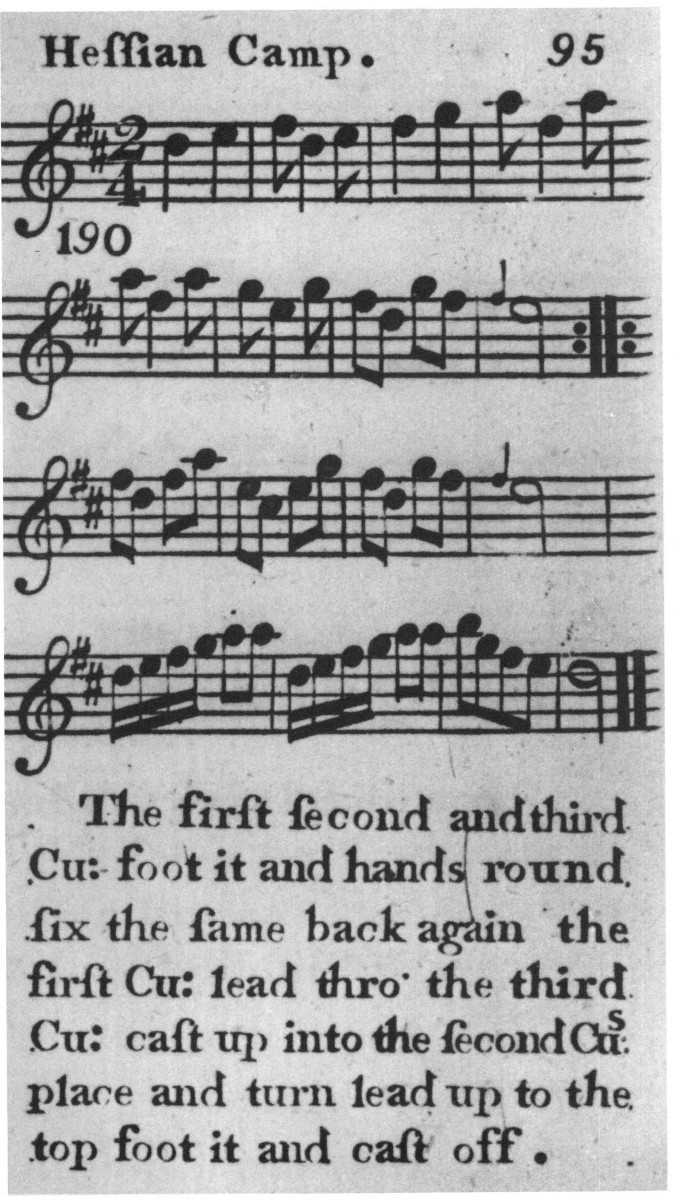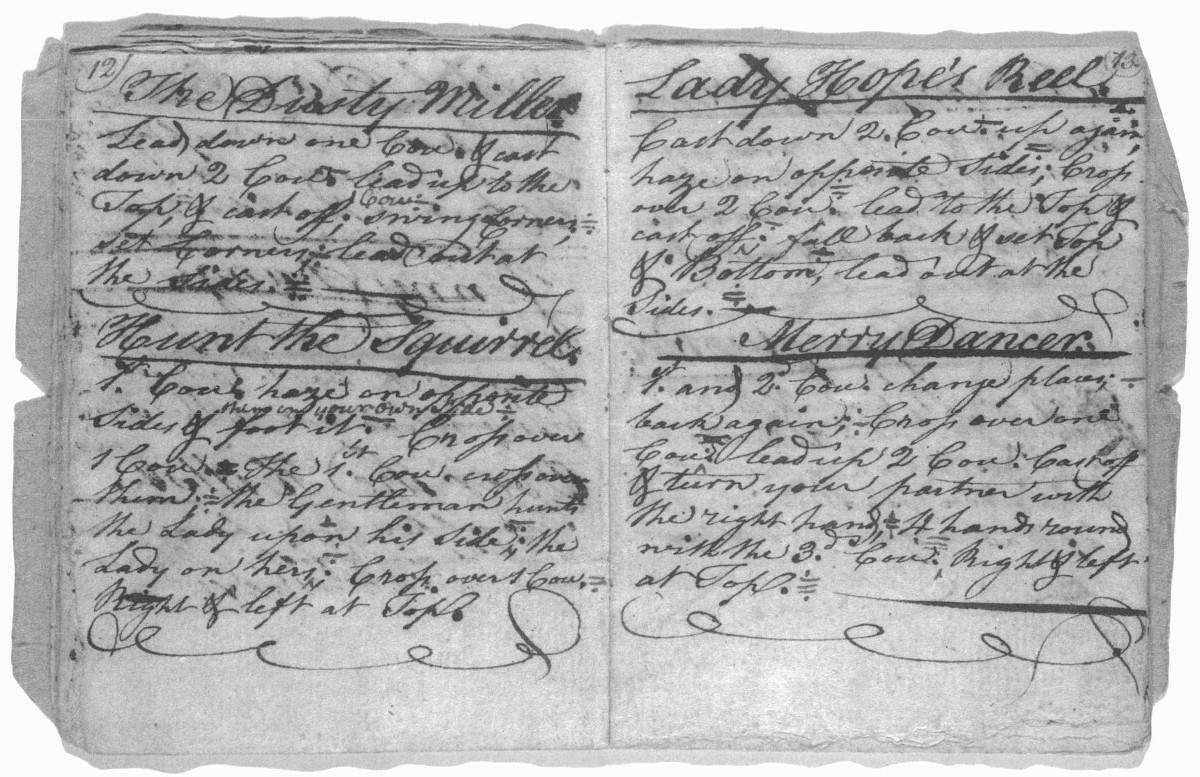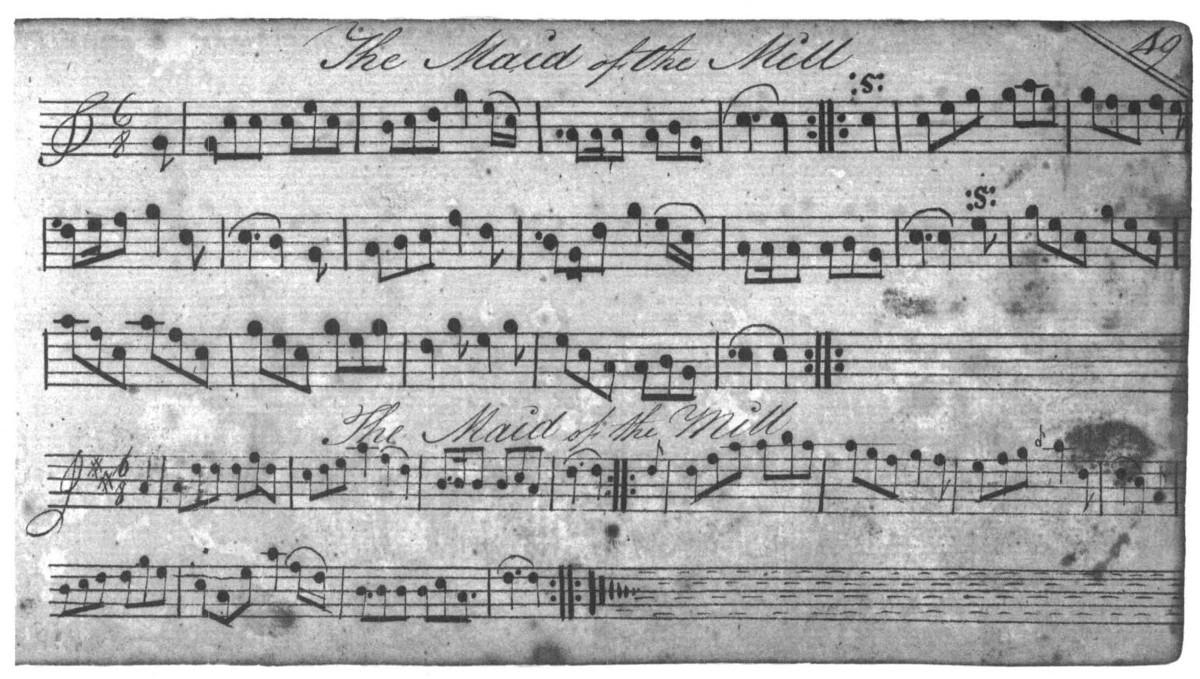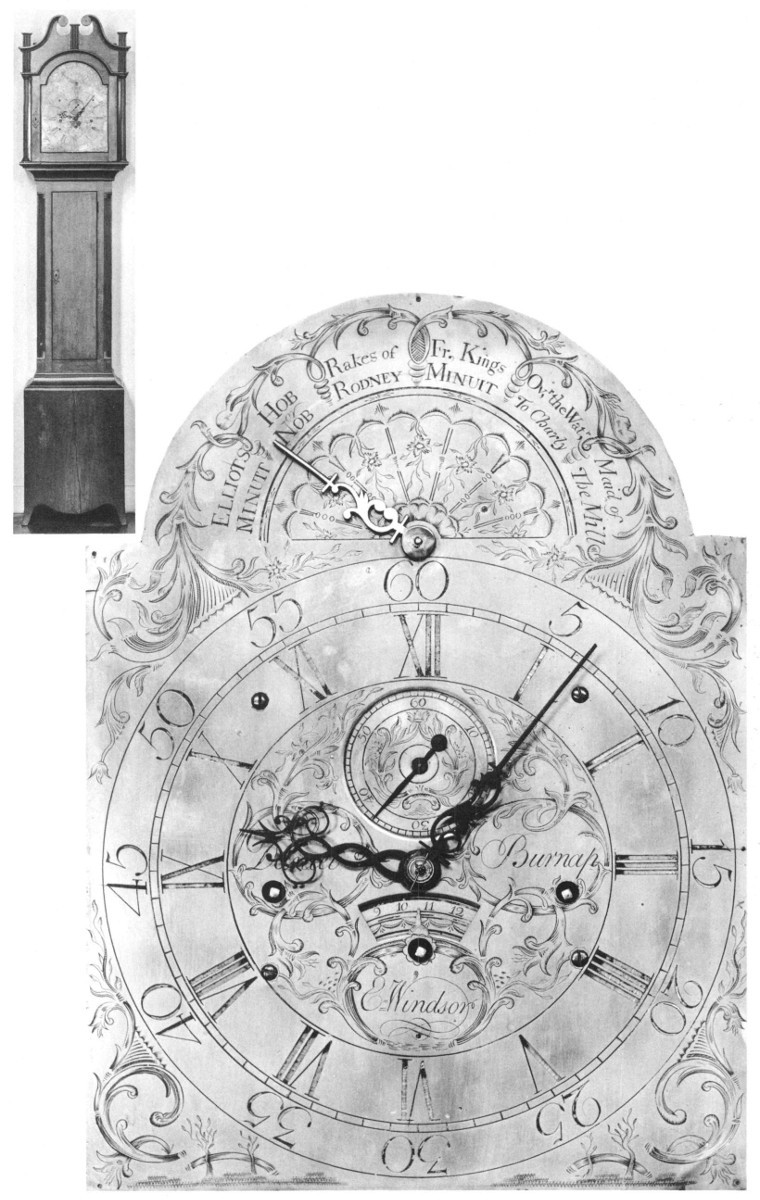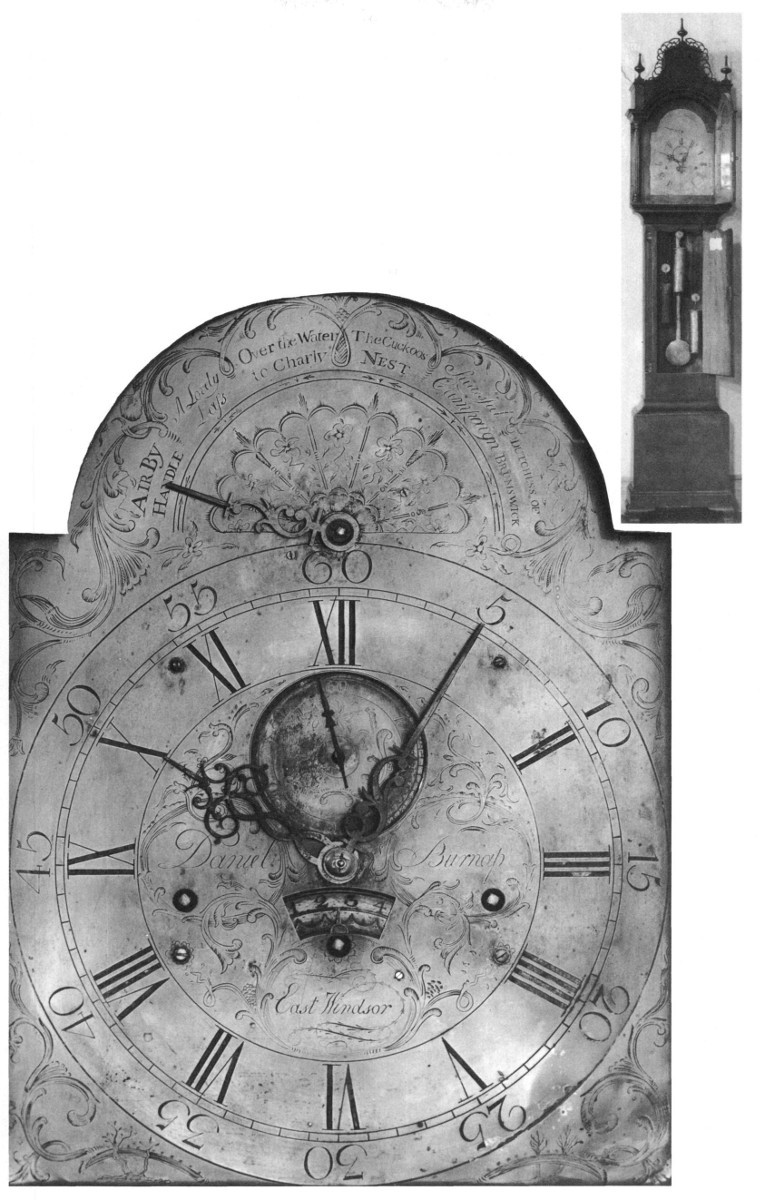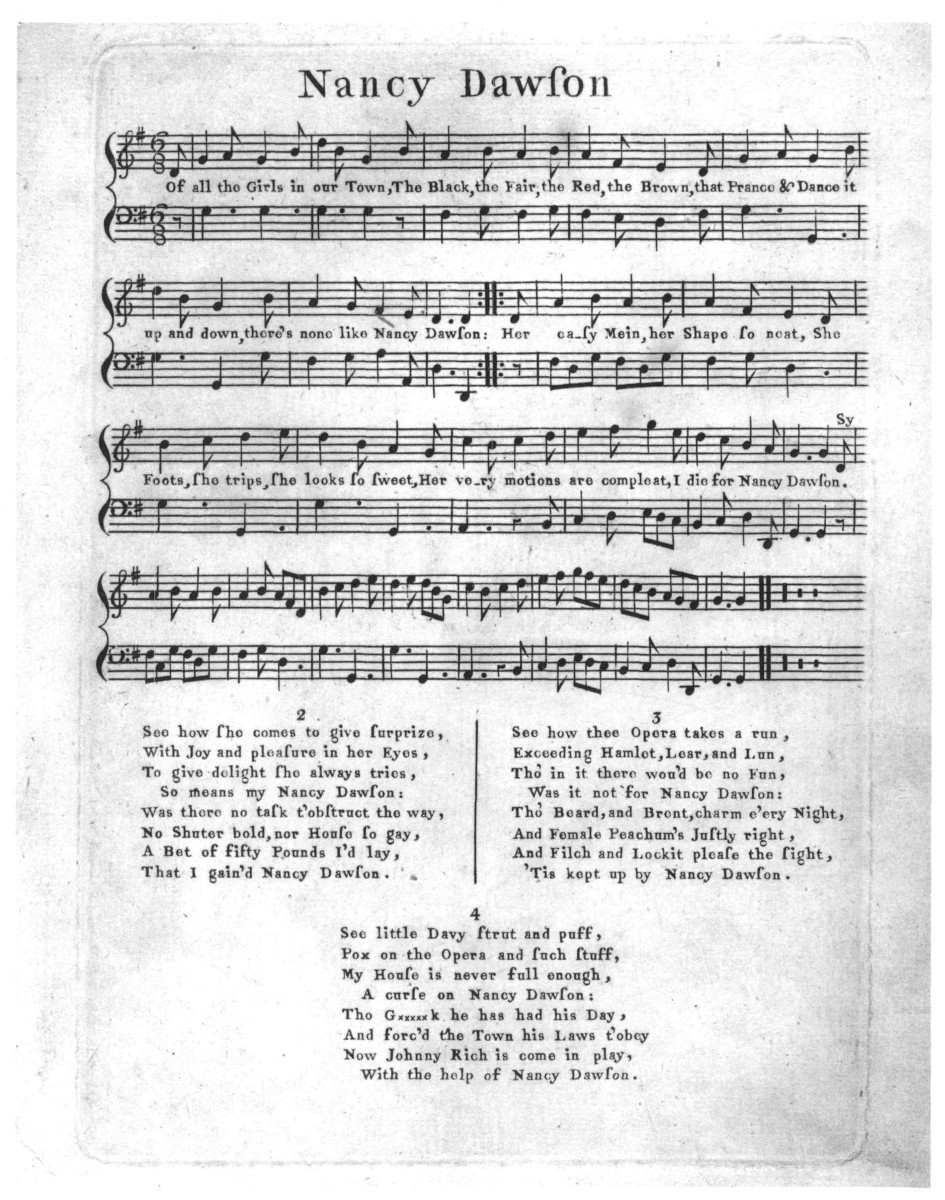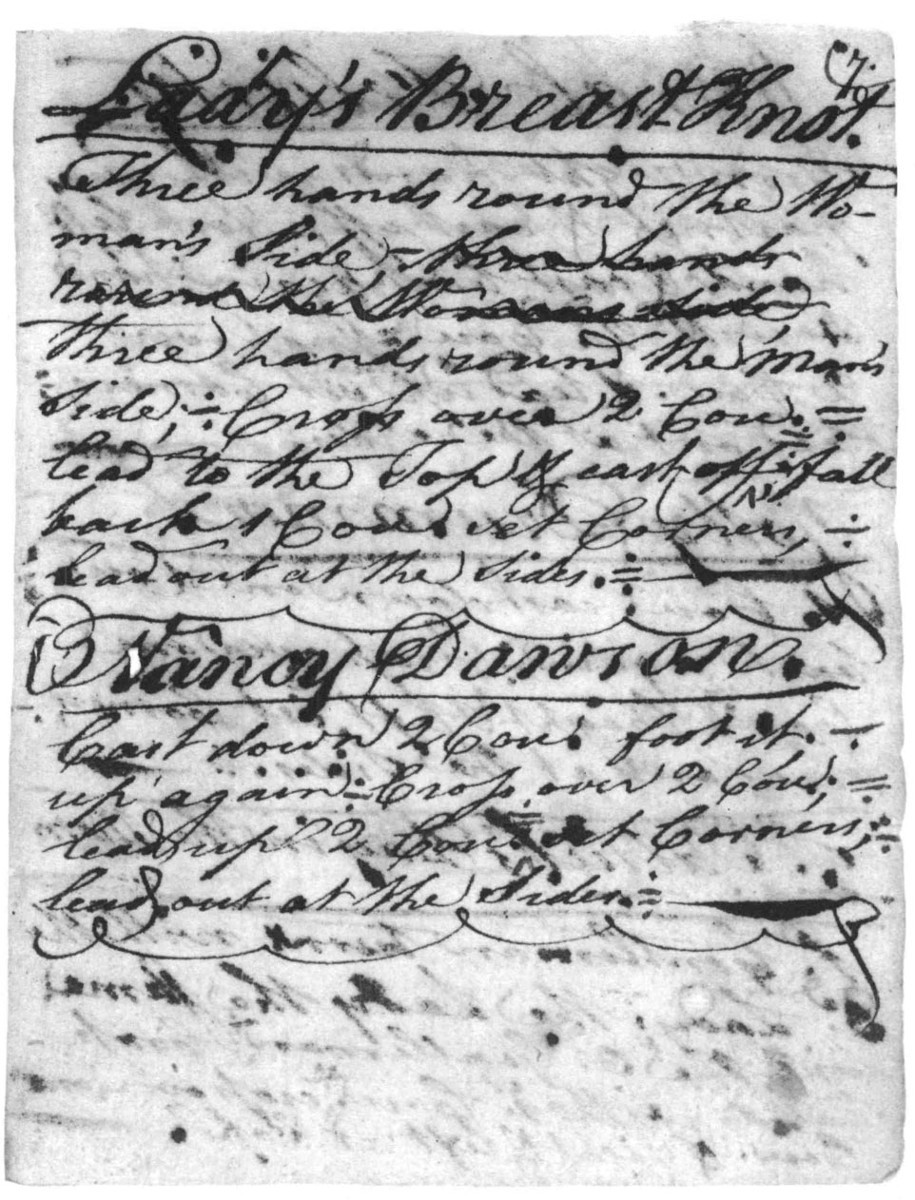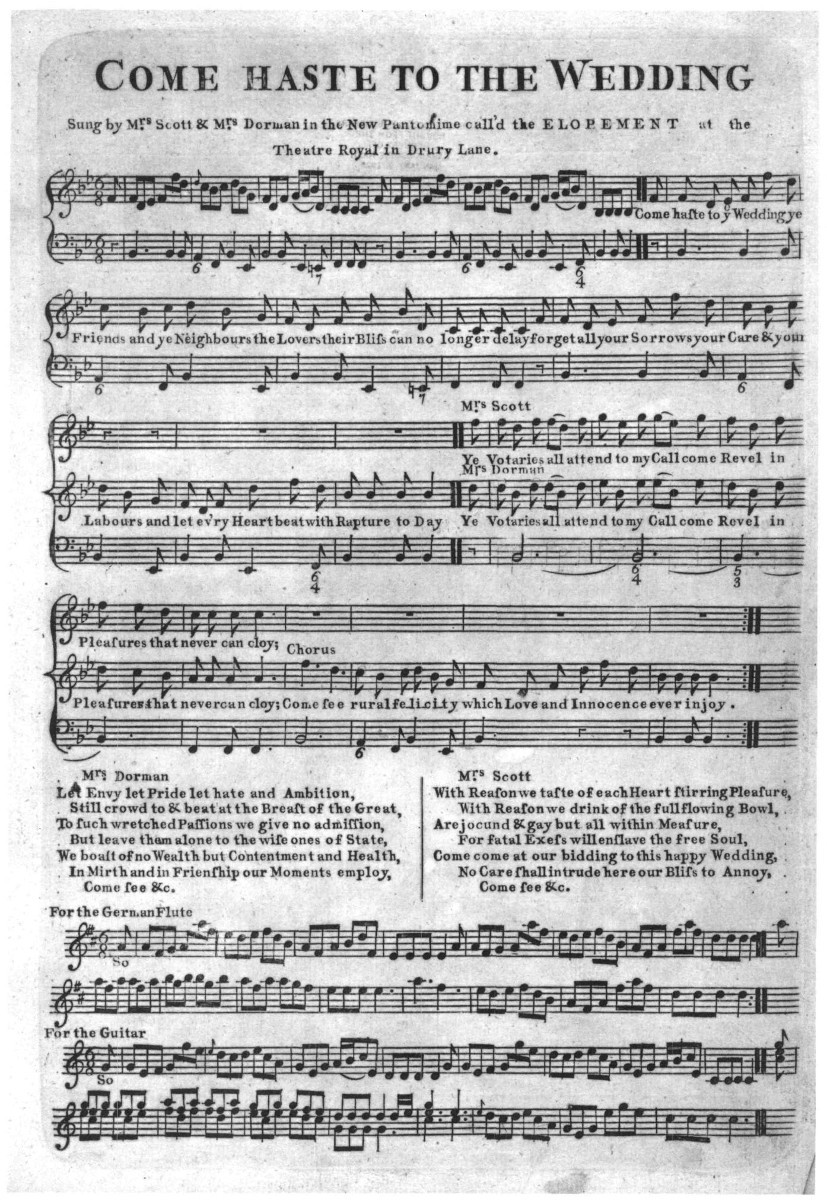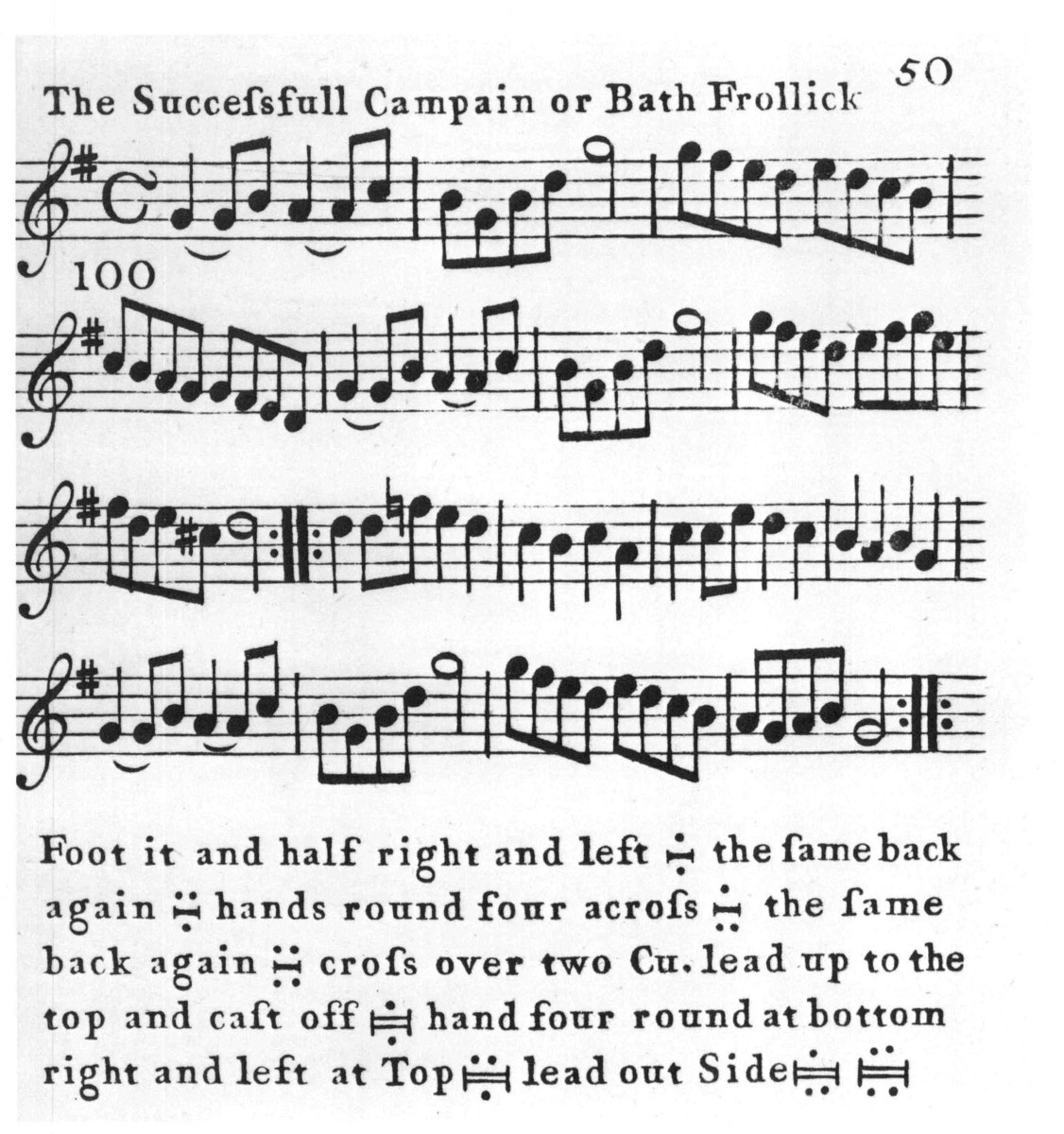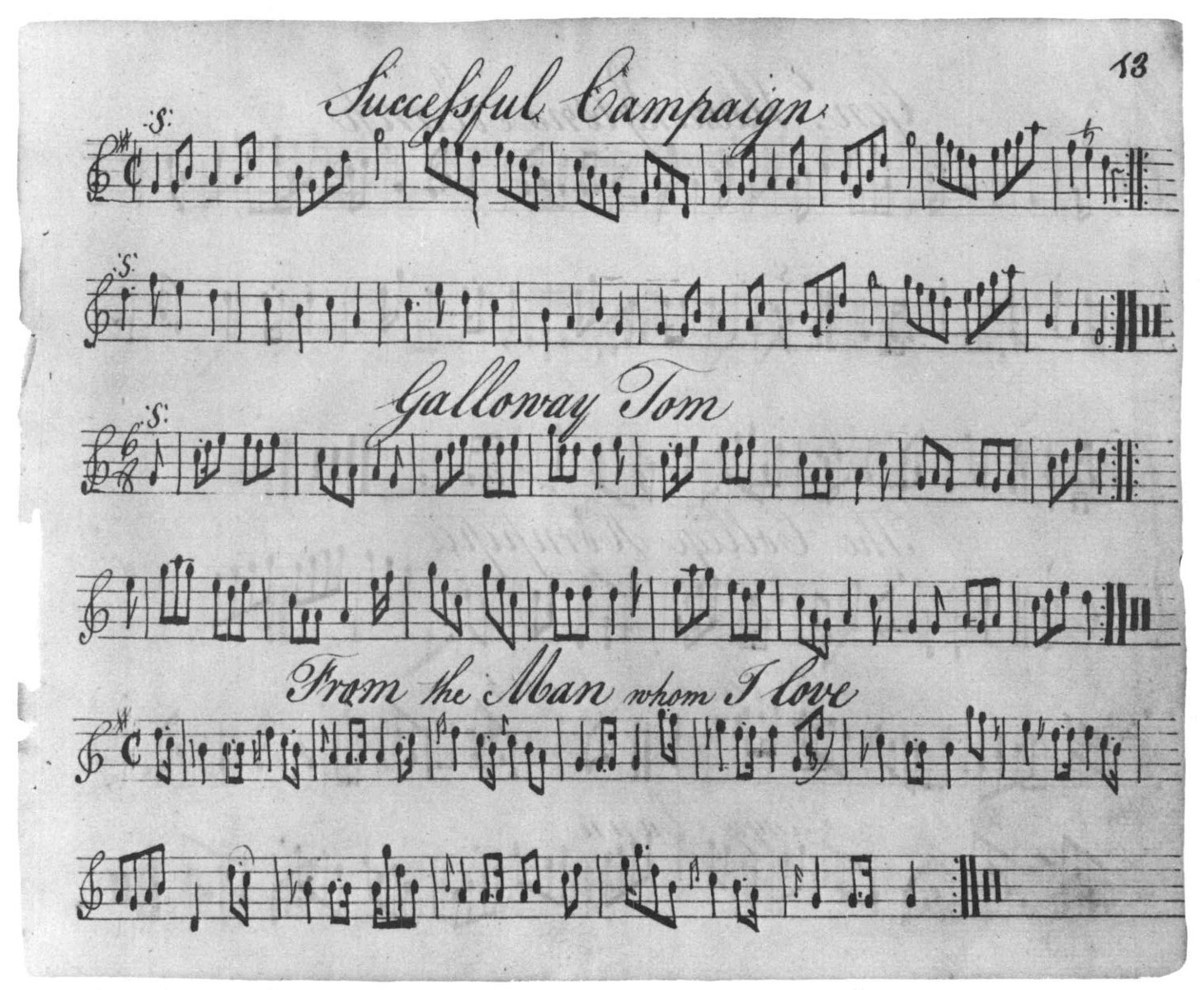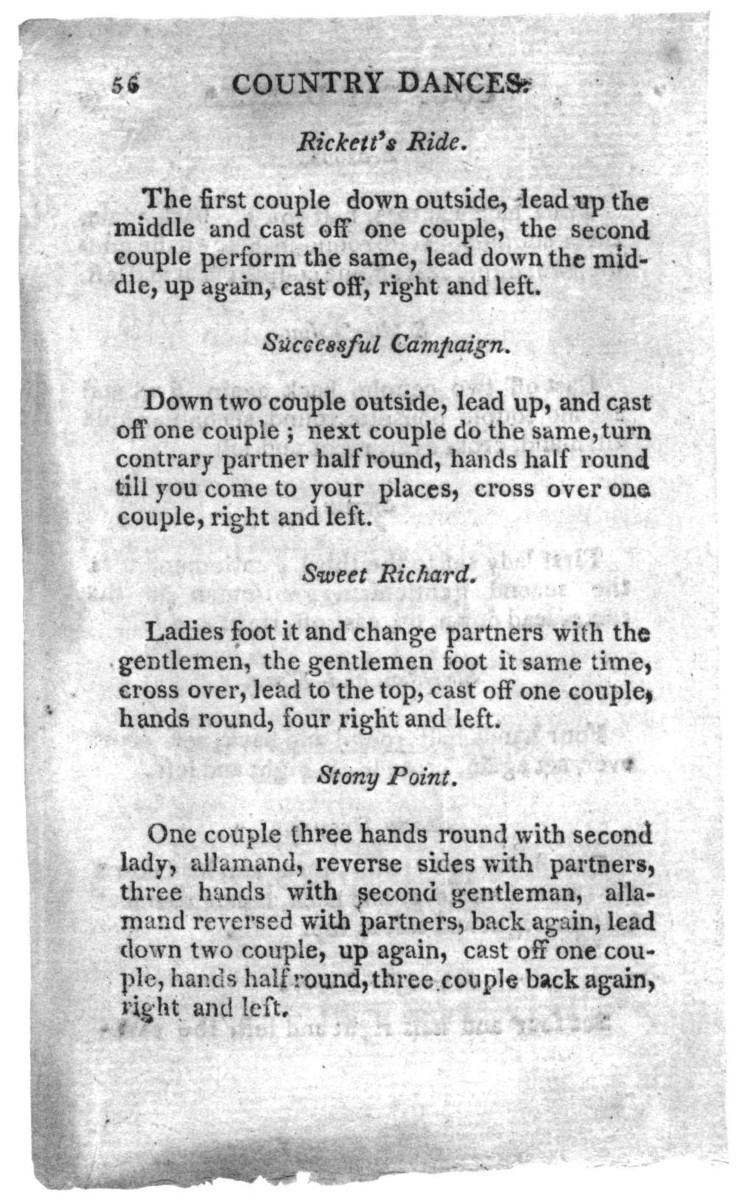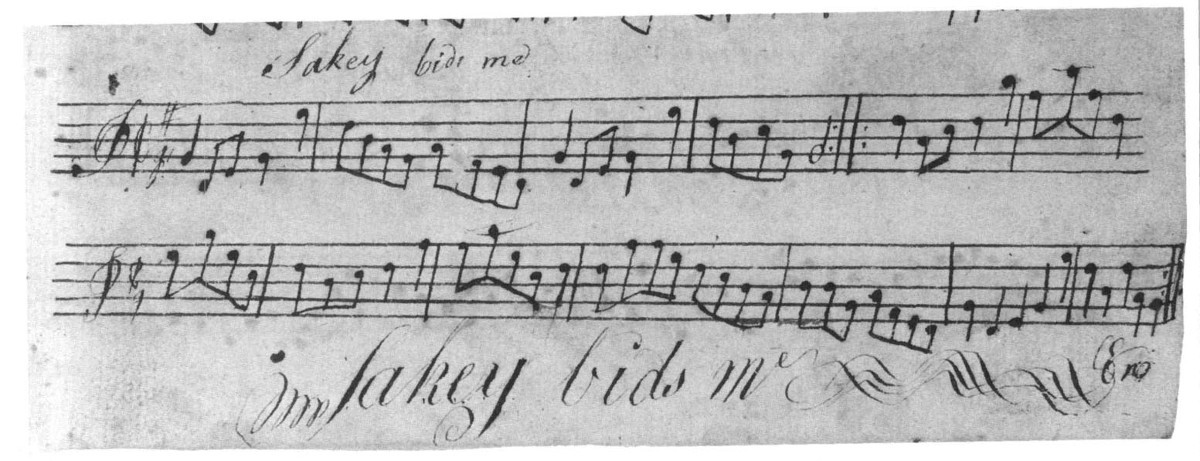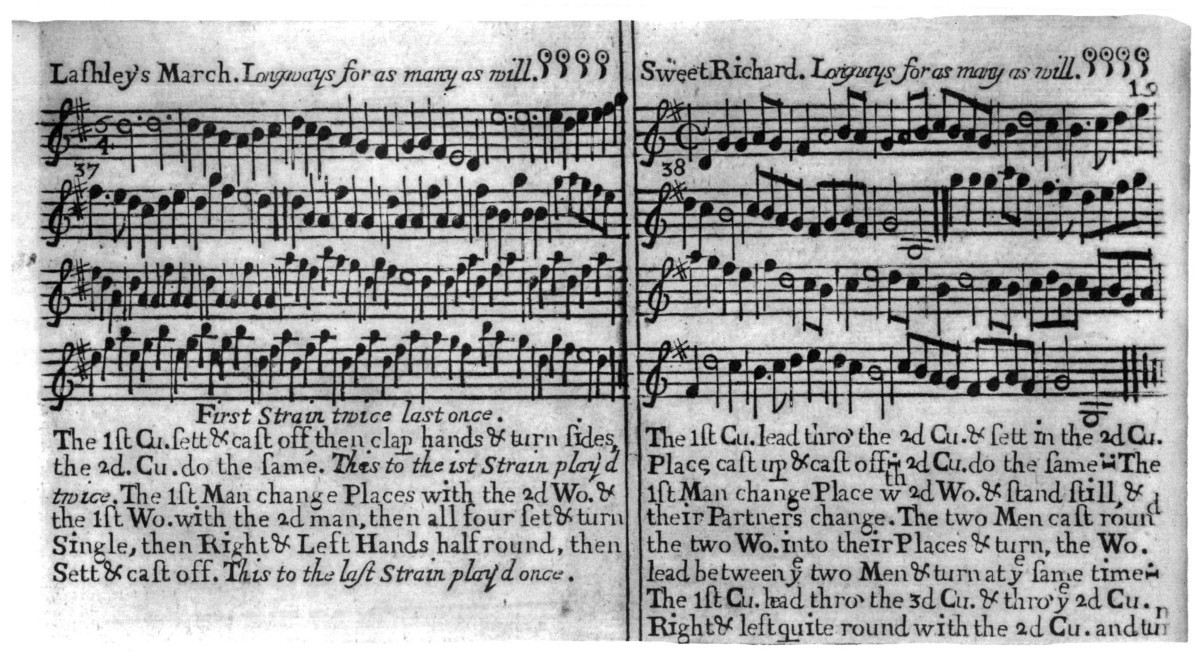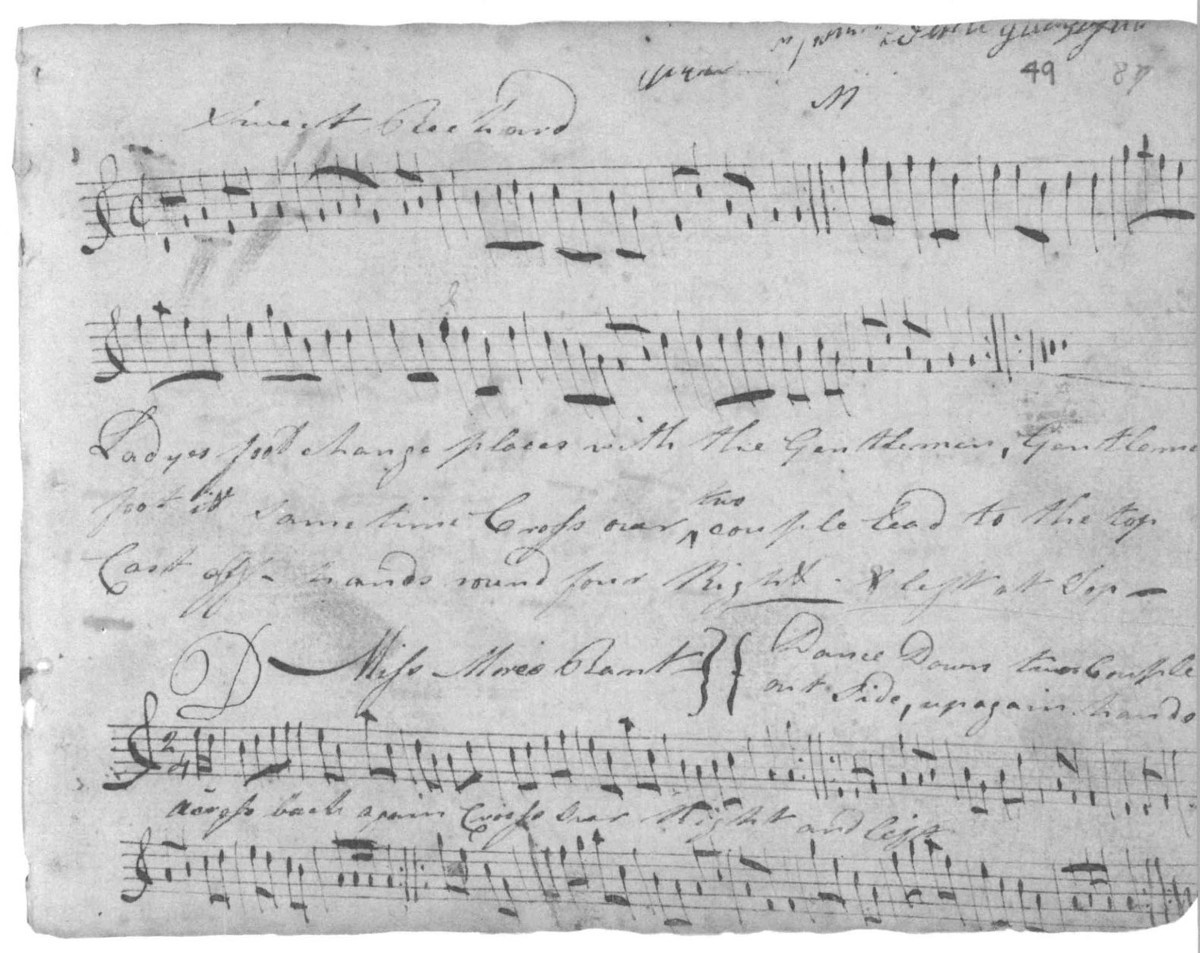MUSIC IN COLONIAL MASSACHUSETTS 1630–1820
Music in Public Places
Andrew Barton’s The Disappointment (New York, 1767) is thought to be the first ballad opera written in North America. It employed many old favorite English songs including “Nancy Dawson,” “Over the hills,” “Shambuy,” “Black joke,” and “The lass of Paties mill.” The English country dance “Excuse Me” was used as the finale (fig. 1). Clearly, England was the source of music popular in the American colonies in the eighteenth century.
As was typical of the era, Barton cited only the title of the tune to be used for each air. He did not include the music because the performers would usually be familiar with the melodies. If they were not, the tunes were readily obtainable from standard fife or dance manuals. “Excuse me,” for example, was found in The Compleat Country Dancing Master (London: J. Walsh and J. Hare, 1718), volume i, and in The Dancing Master, 18th edition (London: W. Pearson, after 1728), volume i.
JOY VAN CLEEF and KATE VAN WINKLE KELLER
Selected American Country Dances and Their English Sources
PERCY SCHOLES and other modern scholars exploded the long-standing myth of Puritan hostility to music and dance; when they did so, they revealed the large hiatus in our knowledge of colonial culture which the myth had been concealing.1 Recent research is providing data with which to fill that gap; but, as in other areas, a great deal remains to be learned, particularly about dance.
Much is known about dance in England in the sixteenth and seventeenth centuries; likewise there is substantial information about dance in both England and New England in the eighteenth century. That English and American dance in the eighteenth century were similar permits conjecture that dance in seventeenth-century America must not have been too unlike that in England during the same period.
Both dance and music were important elements in the life of seventeenth-century Englishmen, including those who emigrated to New England. Governor Winthrop of Massachusetts and his son John, later governor of Connecticut, for example, both read law at the Inner Temple in London,2 where dancing was an obligatory activity, as it was at all the Inns of Court.3 But for the first fifty years or more in the New World comments about dance came from its critics rather than its advocates. Various town ordinances reveal that dancing, along with other recreational activities, was forbidden on the Sabbath, that persons participating in drunk, disorderly, or lascivious dancing were reprimanded or fined, and that a halt was put to dancing in taverns after weddings.4 From this evidence one can assume that there was less-objectionable dancing taking place, for nowhere is dancing per se forbidden. Similarly, drunkenness was preached against and those found drunk were punished, but the use of alcoholic beverages was not forbidden.
Though it is quite true that the Puritans opposed dancing which they considered to be “lewd” or “an incitement to adultery,” their objections were partly but by no means wholly on religious grounds. The Puritan leaders were practical and hardheaded administrators, keenly aware that a disciplined, orderly, and cohesive society was necessary for the survival of the precarious new settlements, and they disapproved of anything which kept people from work that needed to be done.
Still, the question remains: if dance was accepted and common in the seventeenth century, why is there so little mention of it in the records? The answer seems to be that dance was informal, unscheduled, and spontaneous. It took place in homes, in taverns, and perhaps out-of-doors, as a customary part of festive occasions; but there were not gatherings specifically for the purpose of dancing. Dance performances of any sort would certainly have been forbidden, had they been available.
The dances which the Puritans and their compatriots knew and enjoyed have been preserved for us in The English Dancing Master, published by John Playford in 1651, and in the successive editions produced by him and other members of his firm throughout a period of seventy-five years.5 These dances were known as ‘country dances’; but while they did have folk origins, they had been reworked into an amusement for the courts and estates of the landed gentry and were no longer rustic in nature. They were not couple dances, but group dances resembling present-day square and contra dances, of which they are ancestors.
The country dances were not technically difficult and no doubt young people learned them from their elders as they did other skills. But apparently, as the comforts and refinements of life began to become available after the privations of gaining a foothold in the New World had been surmounted, there arose a demand for more professional instruction.
The advent of several unsavory characters seeking to set themselves up as dancing masters in Boston drew the wrath of one of the most famous preachers of the day. In the well-known pronouncement believed to have been written in 1684 by Increase Mather in collaboration with his fellow Congregational ministers, An Arrow Against Profane and Promiscuous Dancing Drawn out of the Quiver of the Scriptures, many harsh things are said against dancing and dancing masters. Yet the pamphlet as a whole, if carefully read, indicates that by no means all dancing and all dancing masters are included in these strictures.
In response, for instance, to Plea. 2 (of those who are advocates of dance) that “The Design of Dancing is only to teach children good Behavior and a decent Carriage,” the writer says: “Religion is no enemy to good manners, to learn a due Poyse and Composure of the Body is not unlawful, provided it be done without a provocation to Uncleanness, and be not a nurse of Pride and Vanity. If therefore any be disposed to have their children instructed in that which may be truly Ornamental, or a desirable Accomplishment in these respects they may send them not to a Blasphemer, but to some Grave Person that will teach them decency of Behaviour, not Promiscuously, but each sex by themselves; so neither God nor Man will be offended.”6
“Good Behavior and a decent Carriage” were matters of tremendous concern, for fine deportment was the mark of a well-bred person, and required of anyone who wanted to be accepted in good society and to find himself at ease there. “Deportment” was a matter of both physical skill and social expertise, and both lay in the province of the dancing master. As members of the gentry, clergymen, like other conscientious parents, saw to it that their children received a genteel education, which included dancing instruction as a matter of course. They sincerely believed, as did most writers and teachers of the period, that external harmony and grace promoted, or were the reflection of, an inner state of spiritual health7—all the more reason why they would be determined to get rid of persons of low character who set themselves up as dancing masters. Indeed, they succeeded in doing so.
An Arrow implies that there were “grave” and respectable teachers of dance in the community, but does not state who they were. It seems likely that most of them taught other things besides dancing—often music or swordsmanship or academic subjects (fig. 2)—and did not advertise themselves solely as dancing masters.
An Arrow also testifies, albeit reproachfully, to the popularity of mixed dancing: “It is sad, that when in Times of Reformation, Children have been taught in their Catechism that such [mixed] Dancing is against the Commandment of God, that now in New-England they should practically be learned the contrary.”8
Although the sexes studied dancing separately and sometimes danced men with men or women with women for recreation, very few people, not even the most devout Puritans (to say nothing of colonists of other theological beliefs), shared Increase Mather’s concern about mixed or “promiscuous” dancing. Even his revered father-in-law, John Cotton, had not ruled it out, providing it was done with decorum. And New Englanders in general saw nothing objectionable in the highly structured country dances such as those in the Playford collections. If they were properly taught and performed, these dances were approved and enjoyed by respectable New Englanders. The country dance seemed to be considered in a class by itself, exempt from the condemnation meted out to other forms of mixed or “promiscuous” dancing.9 Emphasis was placed on the smooth execution of figures by the whole group or “set” of dancers, rather than on individual virtuosity; and though one danced with a partner of the opposite sex, little physical contact was involved, except taking hands or sometimes “armes.”
When the author of An Arrow declared that it was no time to be dancing jigs and galliards, he probably meant the kind of solo in which the dancer “showed his steps,” and which was used by men for exercise as well as gymnastic display.10 Men might dance a double jig in a competitive show of skill similar to that which can be seen in morris dancing today. At first glance, the dance being done in the John Greenwood painting, Sea Captains Carousing at Surinam, 1752, appears to be such a double jig (or it might be a dancing lesson, as one man is tapping the other with a baton).
After the charter of the New England Dominion was granted in 1692, the royal governor, Sir William Phip, had his residence in Boston which was thenceforth the scene of governor’s balls, birthday balls, and other elaborate entertainments patterned, as might be expected, directly on current English practice.11 Toleration of all forms of Christianity, with the exception of Roman Catholicism, was a provision of the new charter, and an Anglican society supporting the Church of England began to flourish and sponsor these events.
By the early eighteenth century, social life was lavish in the large coastal towns of Boston and Newport. Another well-known sermon which concerns dance was preached by Cotton Mather, the son of Increase. In A Cloud of Witnesses; Darting out Light upon a Case too Unseasonably made Seasonable to be Discoursed on (Boston, 1700), he rehearsed many of his father’s objections to dancing, but his real attack was not on dancing as such but on the extravagant balls where it occurred. He implied that even his fellow ministers did not support him, and one gathers that some of his parishioners were straying off to Anglican parties.12 His targets were late hours, extravagance, immodest dress, pomp and vanity, and lewdness.
With or without the approval of the Puritan clergy, dancing continued to grow in popularity with all classes of society. Eighteenth-century French and English publications give more precise information about contemporary dance than do those of the preceding century.13 The dance steps taught by the dancing master—the minuet, gavotte, rigadoun, and bourré, to name some of the more popular ones—were those of the French ballroom which the English had assimilated, just as the French had adopted the forms and figures of the English country dance. Insofar as it was possible, formal balls in elegant colonial society were conducted in the same way as they were in London or at the fashionable watering places outside London such as Tunbridge Wells, Epsom, and Richmond. A ball would open with minuets danced by the most important guests, one couple at a time in the order of their precedence. These might be followed by a few composed dances with specified steps that had to be learned in advance. Most of the evening, however, was devoted to the country dances, which became more and more popular.
The seventeenth century dances as recorded in Playford’s dance manuals took many forms: circle dances, sets for two, three or four couples, and squares for eight, as well as the formation “longways for as many as will.” It was this last form which won out over all the others, and in the various dance tutors printed in England after 1725, the longways had little or no competition (fig. 3). The more difficult and complicated dances were crowded out in favor of simpler ones using a limited repertory of figures and requiring no specific steps, although the French steps could be used if the dancers chose. The basic form of the longways, a line of men facing a line of women, survives in today’s contra dance. The longways dances were known and enjoyed by all classes of society in both England and New England (fig. 4). They were performed in styles which varied as much as the circumstances in which they were danced, from barn-raising frolics to formal balls and elegant assemblies.
The music for dance was drawn from the vast reservoir of popular tunes which were as well known as the dances themselves in England and the English colonies. Particularly before the 1650s the survival and transmission of these tunes depended on several facts: they had to be catchy, easy to learn and hard to forget, playable on any kind of instrument, or singable if no instruments were available. Some of the tunes first appeared anonymously in the sixteenth century while others were newly composed popular tunes of their day. The dances took their names from the tunes they employed. The same tunes also served as settings for songs, military music, and as themes for elaborate keyboard and lute compositions.
Intensive search has so far revealed ten New England dance manuscripts—eleven, if the double collection of Clement Weeks and “D. Smith” is counted as two items. Two additional ones come from just outside the boundaries of New England, from Delaware and Montreal. These last two are in the same format as the New England manuscripts, are from the same era, and contain very similar material. There is also a detailed description of another manuscript and its contents in George Champlin Mason’s Reminiscences of Newport. Though the whereabouts of this item are not known, the description makes it clear that it closely resembled those now extant.
Together the eleven manuscripts (when duplications are omitted) contain 212 titles.14 Despite the fact that the titles mention reels, hornpipes, allemands, rants, jigs, and marches, all are longways country dances except for three cotillons (in the Asa Wilcox ms). This confirms that the simpler dances which could be learned with little instruction outweighed the others in popularity. The New England manuscripts give directions for dances but include no music. The repetition of titles indicates that they came from similar sources and date from the same period. All are in the form of little pocket notebooks or commonplace books, which suggests that this may have been the customary way of preserving dances learned in class or from friends.
All the American manuscripts seem to come from a period of about fifteen years, between 1780 and 1795. It is tempting to hypothesize that during these years people wrote out dance directions because printed dance books were hard to obtain, particularly during the period after British imports were cut back during the Revolution and before dance books printed in America became common about 1800. The fact is, however, that earlier dance manuscript collections were made in the same form in England and there was certainly no scarcity of printed dance tutors there.15 Although more American manuscripts of an earlier date may turn up, the evidence presently available simply supports other evidence that dancing was a very popular and important pastime in the closing decades of the century.
Almost all of the dance and music titles found in New England manuscript sources have been located in English published sources. There can be little doubt as to the cultural dominance of the Mother Country down to and through the Revolutionary period. Americans marched into battle playing English tunes, and celebrated their victories with English dances. They did, however, make up their own songs and ballads to the tunes they liked, as is discussed elsewhere in this volume.
The twenty-one titles which follow in detailed study were selected because they are among those which appear the most frequently in the English and American sources examined (see bibliography) and which illustrate their close relationship. All of these dances have a close family resemblance; however, the dances appearing under the same title are not necessarily identical, as the figures illustrate. A popular tune might be used for several different versions of a dance, just as it often served for several different song texts.
J.v.C.
The Dances and Their Sources
kate van winkle keller
collection titles abbreviated in text
Johnson, 200 Country Dances (1751): A Choice Collection of 200 Favorite Country Dances (London: J. Johnson, 1751). Yale University.
Johnson, Wright’s Collection (ca. 1742.): Wright’s Compleat Collection of Celebrated Country Dances, vol. i (London: J. Johnson, [ca. 1742]). Essex Institute.
MWA, 200 Country Dances (ca. 1740): [A Choice Collection of 200 Country Dances (London: ca. 1740)]. American Antiquarian Society.
Rutherford, 200 Country Dances (ca. 1756): Rutherford’s Compleat Collection of 200 Country Dances, vol. i (London: David Rutherford, [ca. 1756]). Yale University.
Thompson, 200 Country Dances, vol. i (1758): Thompson’s Compleat Collection of 200 Favorite Country Dances, vol. i (London: Charles and Samuel Thompsons, [1758]). John Carter Brown Library.
Thompson, 200 Country Dances, vol. ii (1765): Thompson’s Compleat Collection of 200 Favorite Country Dances, vol. ii (London: Charles and Samuel Thompsons, [1765]). John Carter Brown Library.
Thompson, 200 Country Dances, vol. iii (1773): Thompson’s Compleat Collection of 200 favorite Country Dances, vol. iii (London: Charles and Samuel Thompsons, [1773]). Forbes Library, Northampton, Massachusetts.
Walsh, Country Dancing-Master (1718): The Compleat Country Dancing-Master (London, J. Walsh, 1718). Library of Congress.
Walsh, Country Dancing-Master, book 2 (1719): The Second Book of the Compleat Country Dancing-Master (London, J. Walsh, 1719). Library of Congress.
allemand swiss
Although the authors of these manuscripts spelled the title “Allemand Swiss” differently, they were both recording one of the most popular country dances of late eighteenth century America. Henry Beck and many other American musicians wrote out “Allemand Swiss” in their copybooks of tunes (fig. 6),16 and Aaron Thompson provided one of the rare instances when a manuscript writer copied the dance as well as the music (fig. 5):
Allmon Swiss Country Dance
First Gentleman Allemande reversd with 2d: Lady. 2n:d: Gentleman / the same with 1st: Lady. – lead down 2 Couple up Again – / Cast off one Couple. six hands round, half – back again, right / & left at Top –
The music of “Allemande Swiss” first appeared as “Cotillon allemand Swiss” in the English publication the Compleat Tutor for the Guittar (London: C. & S. Thompson, [1770]), page 28.17
In 1794, dancing master John Griffiths included in his Collection published in Northampton, Massachusetts, the directions for a country dance called “Allemand Swiss with a New Figure” adding perhaps his personal stamp to an already popular dance (fig. 7). Asa Willcox included two dances by this title in his manuscript collection dated Connecticut, 1793. One is a cotillon and the other is the same country dance that Aaron Thompson copied.18 These two sources clearly indicate that this country dance was well known by the same title with the same figures. It was probably taken from an English collection of about 1780.
The first two phrases of the melody “Allemand Swiss” are identical to the tune known as “The faithfull shepherd” found in Twenty Four Country Dances (London, [1769]) (fig. 8). This dance is somewhat similar to “Faithful Shephard” in Asa Willcox’s manuscript19 (fig. 9), and also to that by the same title in the Gentleman & Lady’s Companion (Norwich, [Connecticut], 1798) (fig. 10).
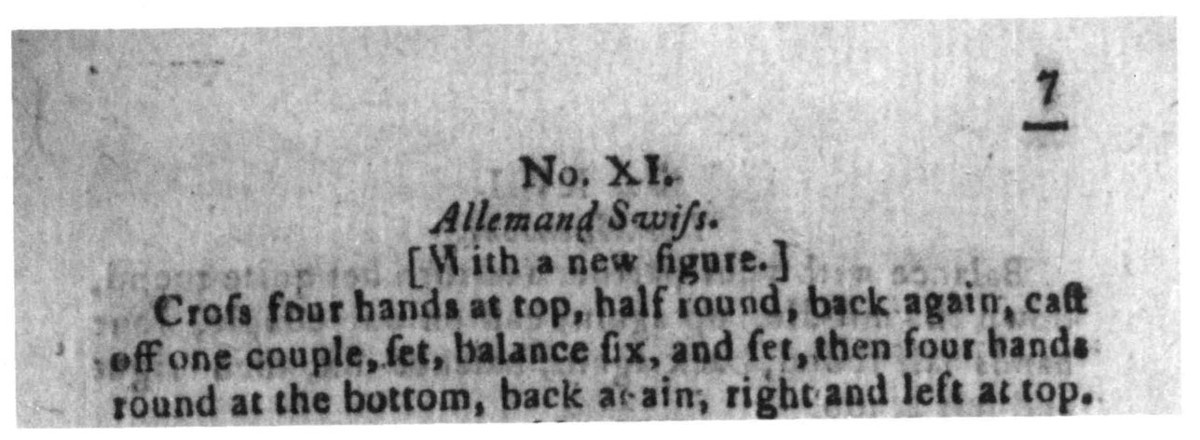
Fig. 7. Page 7 of John Griffiths, A Collection of the Newest Cotillions and Country Dances (Northampton, [Mass., 1794]).

Fig. 10. Page 19 of Gentleman & Lady’s Companion (Norwich, [Conn.]: J. Trumbull, 1798).
A description of a party held near Newport, Rhode Island, in 1752 reported that three country dances were performed by the company: “Faithful Shepherd,” “Pea Straw,” and “Arcadian Nuptials.”20 As is the case with “Faithful Shepherd,” these last two are also found in English sources with dates earlier than the American ones. The title “Pea Straw,” for example, is found as early as ca. 1740 in the English imprint MWA, 200 Country Dances (ca. 1740), page 79.21 It reappeared again in 1799 in the American publication A Collection of Contra Dances (Walpole, [New Hampshire], 1799) (fig. 11). “Arcadian Nuptials” appeared first in Thompson, 200 Country Dances, volume iii (London, 1773), page 100, second in Asa Willcox’s Connecticut manuscript (1793) as no. 2 (fig. 12), and third in the Select Collection (Otsego, [New York], 1808) (fig. 13). All these dances have the same figures.
balance a straw
The melody and title of this dance are derived from the choruses of the first and last stanzas of a popular song by the Englishman James Oswald (d. ? 1769) (fig. 14). This song was sung in The Reprisal, a play with incidental music which was first performed in London in 1757. The opening line of the song, “From the man whom I love,” supplies the other title by which the tune was also known both in England and America. (See also fig. 61.)
Clement Weeks must have copied the directions for the dance “Balance a Straw” from a printed source, for he carefully noted the symbols which indicate to which phrase of the music the figure is to be danced. These symbols are found in collections of country dances printed in England throughout the eighteenth century.
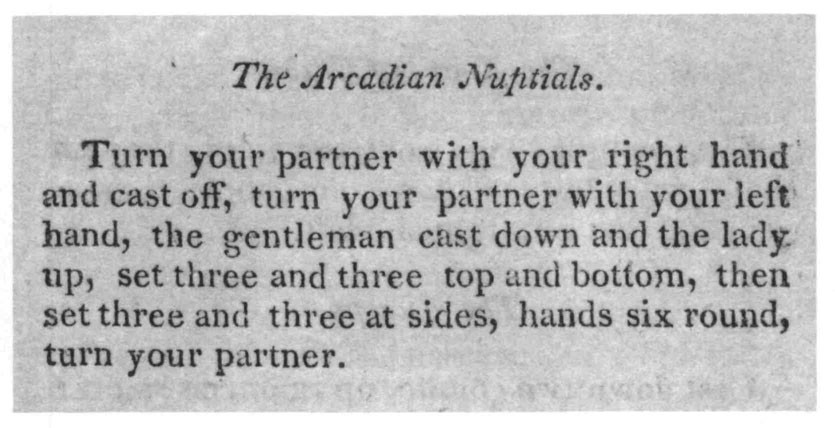
Fig. 13. Page 64 of Select Collection of the Newest . . . Country Dances (Otsego, [N.Y.]: H. & E. Phinney, 1808).
cast back 1 Cou.  up again, /
up again, / lead down 2 Cou.
lead down 2 Cou.  up again,
up again,  / The 2d. Cou. do the same,
/ The 2d. Cou. do the same,  set. / at Top & bottom,
set. / at Top & bottom,  lead out at the Sides.22
lead out at the Sides.22
the baulk
Copied twice into Clement Weeks’ manuscript of country dances, on page 10 (fig. 15) and again on page 23, “The Baulk” is found earlier as a country dance in two English editions: in Johnson, Wright’s Collection (London, ca. 1742), i, 4923 (fig. 16), where it is called “The balk”; and in Thompson, 200 Country Dances, volume ii (London, 1765) (fig. 17). All three have different figures but were danced to the same tune.
Fig. 16. Page 49 of Wright’s Compleat Collection of Celebrated Country Dances, vol. i (London: J. Johnson, [ca. 1742]).
black joke
“Black joke” was widely popular as a vulgar and bawdy street song in England in the early part of the eighteenth century (fig. 18), and its popularity continued into the nineteenth century both in England and America.24 It was cited in the colonies as the tune for air 13 in Andrew Barton’s ballad opera The Disappointment (New York, 1767).
“Black joke” was also well known as a dance tune early in the eighteenth century. It was played in London as early as 1734 in Henry Carey’s burlesque stage piece Chrononhotonthologos where it was called “that lowbrow little tune that has been used as an interval tune for years,” referring to the music for dances performed in the entr’acte interval at the playhouses.25 “Black Joke” appeared with tune, directions, and two different spellings in two English dance collections: Johnson, Wright’s Collection (London, ca. 1742) (fig. 19), and Thompson, 200 Country Dances, volume ii (fig. 20). A different dance by this title appears in Clement Weeks’ Connecticut manuscript. (See fig. 15.)
Fig. 19. Page 15 of Wright’s Compleat Collection of Celebrated Country Dances, vol. i (London, [ca. 1742]).
Fig. 20. Page 94 of Thompson’s Compleat Collection of 200 Favorite Country Dances, vol. ii (London, [1765]).
A very popular instrumental tune throughout the century, “Black joke” is unusual in the number of bars in each phrase. While most dance tunes are two even phrases of eight bars each, the opening phrase of this tune has six measures; the second, ten. Henry Beck’s version of this tune is a common one; it appears in this form in many manuscript collections of the 1780s and 1790s in America (fig. 21).
college hornpipe
Often called “Sailor’s hornpipe” today, this lively tune which Beck included in his 1786 manuscript (fig. 22) was well known as the “College hornpipe” in North America in the late eighteenth century. It first appeared in print in England in the Compleat Tutor for the German Flute (London: Jonathan Fentum, [ca. 1766]) (fig. 23). It reappeared in Geminiani’s New and Compleat Instructions for the Violin (London: Longman and Broderip, [1780]), page 22, and in the Compleat Tutor for the Violin (London: S. A. & P. Thompson, [1790]), page 30. The tune was published in Philadelphia by J. Carr in a collection of popular dance and song melodies entitled Evening Amusement (1796), page 15.
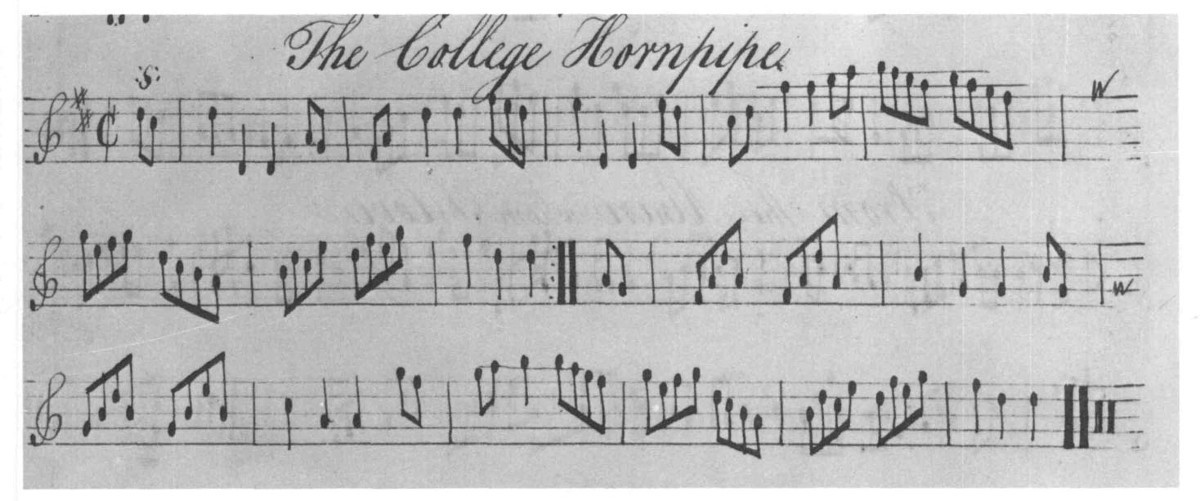
Fig. 22. Page 12 of Henry Beck’s German flute ms (American, 1786).
As country dances, those illustrated are among several to be found in American sources of the period (figs. 24 and 25).
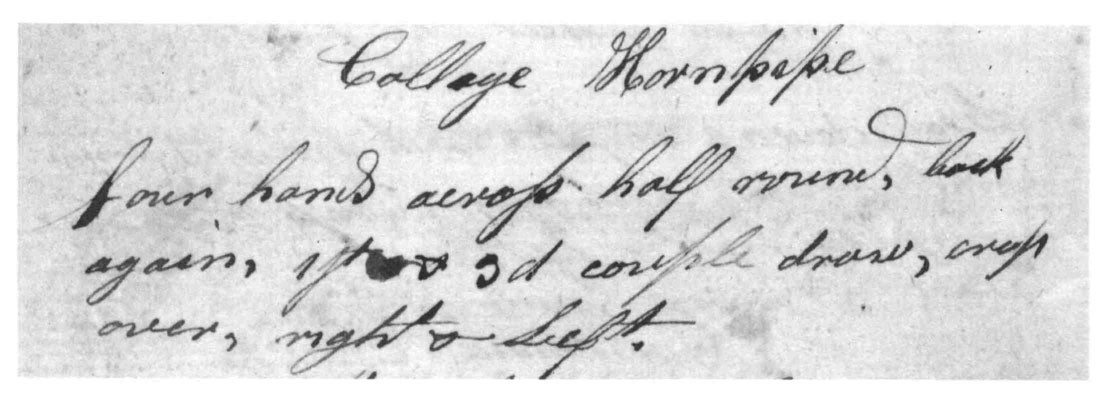
Fig. 24. Page 2v of Nancy Shepley’s dance ms (Pepperell, Mass., ca. 1795).
dusty miller
Three different country dances to the tune “Dusty miller” existed in both England and America, always with the English imprint appearing first. “Dusty Miller” appeared as a dance in England in both Wright’s Collection (London, ca. 1742) (fig. 26) and in Thompson, 200 Country Dances, volume ii (London, 1765), page 93. Essentially the same dance appears twice in Clement Weeks’ manuscript, pages 12 and 17, with different descriptions of the same figures. The figure of the “hey” in the mid-century English dance version had changed to a “lead out at the sides” in the later. (See fig. 44.)
The Dusty Miller
Lead down one Cou. & cast / down 2 Cou  lead up to the / Top,
lead up to the / Top,  & cast off. 1 cou,
& cast off. 1 cou,  swing Corners,
swing Corners,  / set Corners,
/ set Corners,  lead out at / the sides.
lead out at / the sides.  —26
—26
Fig. 26. Page 24 of Wright’s Compleat Collection of Celebrated Country Dances, vol. i (London, [ca. 1742]).
A second dance by the same title was included in the London volume Longman and Broderip’s 5th Selection of the Most Admired Country Dances, Reels, Minuets and Cotillions (London: Longman and Broderip, [ca. 1784]), page 24. This same dance can be found with an American imprint: Select Collection (Otsego, [New York], 1808) (fig. 27).
A third dance by this title appeared in Thompson’s Twenty Four Country Dances for the Year 1798 (London: The Publisher’s Warehouse [Messrs. Thompson], [1798]), page 15.
fisher’s hornpipe
This instrumental tune was probably composed by James A. Fishar, musical director and ballet master at Covent Garden during the 1770s.27 It is included as “Hornpipe # i” in J. Fishar’s Sixteen Cotillons Sixteen Minuets Twelve Allemands and Twelve Hornpipes (London: John Rutherford, [1778]), page 48, and as “Lord Howe’s hornpipe” in Longman and Broderip’s 5th Selection of the Most Admired Dances, Reels, Minuets and Cotillions (London: Longman and Broderip, [ca. 1784]). The tune became widely popular as “Fisher’s hornpipe” and was written out by the American John Greenwood in his copybook of about 1783 (fig. 28).
A country dance was composed to “Fisher’s hornpipe” and first appeared in America in John Griffith’s Collection (Providence, [Rhode Island], 1788) (fig. 29). This dance and tune became a classic, appeared in almost every collection thereafter, and continued in popularity to modern times. With little change it is still played and danced in the traditional repertory of back-country Americans. The version copied by Asa Willcox in 1793 (see fig. 9) is the same dance with the hands across figure omitted, probably accidentally.

Fig. 29. Page 6 of John Griffith, A Collection of the Newest Country Dances and Cotillions (Providence, [R.I., 1788]).
german spa
The tune commonly associated with this title first appeared in England in 1780 as “The new German spa dance” in New Instructions for the German Flute (London: Longman and Broderip, [1780]), page 24. At about the same time “The German spaw minuet” was printed on page 20 of a tutor now preserved at the Litchfield (Connecticut) Historical Society and tentatively identified as New Instructions for the Common Flute (London, ca. 1780).
As a dance the title appeared in Twenty Four Country Dances for the Year 1788 (London, [1788]) (fig. 30). This first page also included “La Belle Catherine,” another country dance which became very popular in America.
Twenty Four Country Dances for the Year 1788 (London: Saml. Ann and Peter Thompson, [1788]) appears to have been known in New England shortly after its publication. Six dances contained in the printed collection of twenty-four, “Ashley’s Flag,” “The Country Attorney,” “Fortune Teller,” “The Grand Turks Dance,” “The New Theatre,” and “The Savoyard’s Frolic,” are copied almost exactly into Nancy Shepley’s collection made in Pepperell, Massachusetts, in ca. 1795.28 “German Spa” in Shepley’s manuscript starts with the same figure but is definitely a different dance to the same tune:
Fig. 30. Page 1 of Twenty Four Country Dances for the Year 1788 (London: Saml. Ann and Peter Thompson, [1788]).
Fig. 31. Page 3 of John Griffiths, A Collection of the Newest Cotillions and Country Dances (Northampton, [Mass., 1794]).
Cast off 1 cop. up again, 4 hands acr- / oss half round and Back again, lead / down the middle, up again and / cast off, obeisance.29
In John Griffiths’ Collection (Northampton, 1794) “German Spa” appeared on page 3 as a cotillon (fig. 31) and on page 9 as a country dance (fig. 32).
The tune from the English dance collection of 1788 (fig. 30) occurs in manuscript sources of the period as well as nineteenth century tune collections published in the United States under the title “German spa” and “New German spa.” A version for two fifes is included in the 1805 Fifer’s Companion (fig. 33).
greensleeves
A somewhat squared-off version of this old English melody was known in the colonies in the eighteenth century, where it appeared as “Green sleeves” (fig. 34) and “Green sleaves & mutton pies” (fig. 35). Henry Beck includes the same first phrase but quite a different second phrase in his version of 1786.
Fig. 32. Page 9 of John Griffiths, A Collection of the Newest Cotillions and Country Dances (Northampton, [Mass., 1794]).

Fig. 33. Page 40 of The Fifer’s Companion, No. 1 (Salem, [Mass.]: Joshua Cushing, [1805]).
The parent tune, “Green-sleeves and pudding-pies,” appeared with a dance in The Dancing Master, 7th edition (London: John Playford, 1686), page 186, and in Walsh, Country Dancing-Master (1718), page 124. Although this tune has a long history and was known in North America, it does not seem to have been particularly popular there in the late eighteenth and early nineteenth centuries.
Two country dances entitled “Greensleeves” appear in American manuscripts of the period, one as no. 21 in Asa Willcox’s Connecticut collection, and another in Clement Weeks’ New Hampshire manuscript (fig. 36).
hessian dance
“Hessian Dance” first appeared in two London publications—in Twenty Four Country Dances (London: Peter Thompson, [1758]), page 2, and again in Thompson’s 200 Country Dances, volume ii (1765) (fig. 37), with a different set of figures.
Fig. 34. Page 16 of Whittier Perkins’ violin ms (Massachusetts, 1790).30
The music of “Hessian dance” as found in the Thompson publications can be found in American sources with several different titles: “Hessian dance,” “Hessian camp,” “Asian camp,” “Ty Tol or the country dance,” and “Old Roger.” Henry Beck copied the tune twice, on page 39 as “Hessian dance” and on page 53 as “Asian camp” (fig. 38).
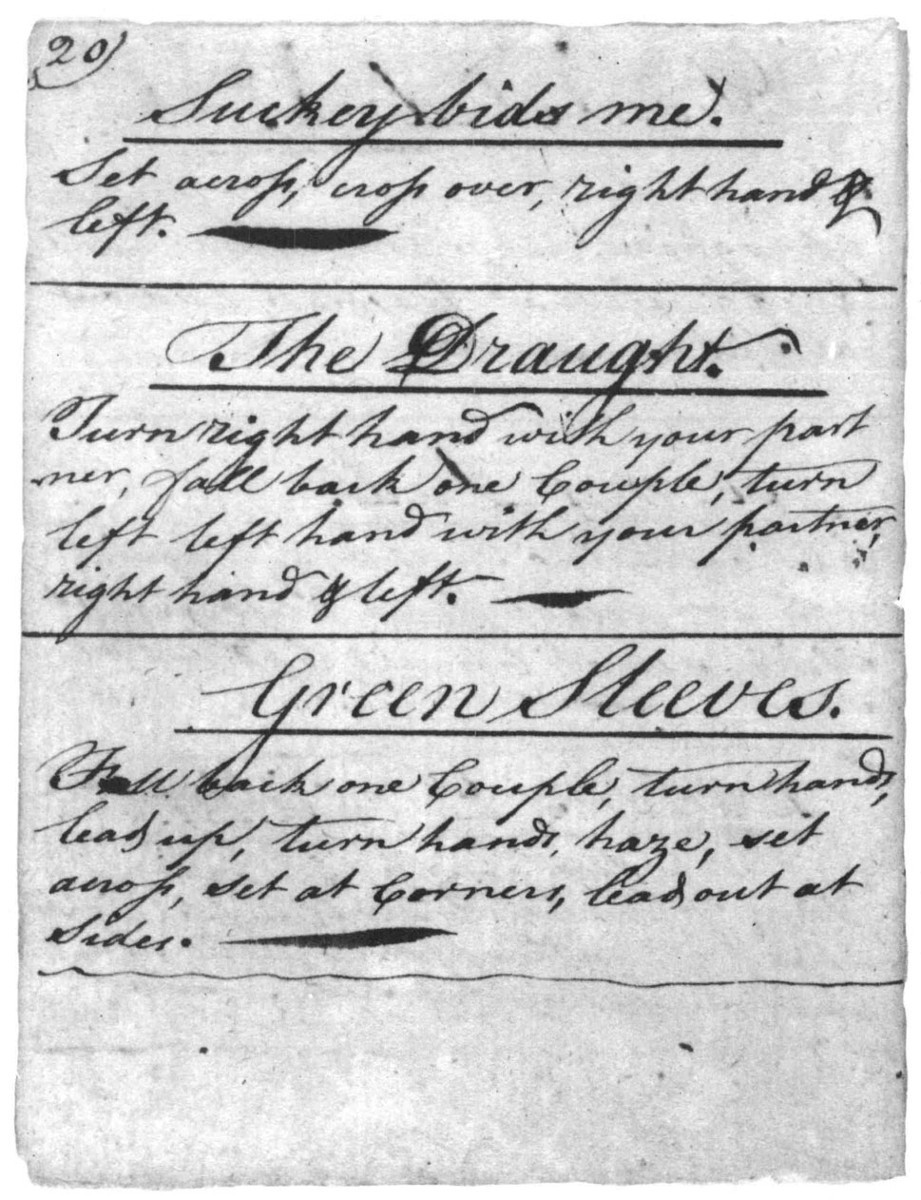
Fig. 36. Page 20 of Clement Weeks’ dance ms (Greenland, N.H., 1783).
Fig. 37. Page 2 of Thompson’s Compleat Collection of 200 Favorite Country Dances, vol ii (London, [1765]).

Fig. 38. Page 53 of Henry Beck’s German flute ms (American, 1786).
Clement Weeks copied a country dance entitled “Hessian Camp” into his collection in 1783 (fig. 39). Although the figures of Weeks’ dance differ from the earlier printed dances, they do fit the same music, a three-phrase tune.
An entirely different dance and tune called “Hessian camp” appeared in London in Thompson, 200 Country Dances, volume in (1773), page 95 (fig. 40). The melody for this dance is in two parts. A similar dance appeared in America in the Select Collection (Otsego, [New York], 1808) (fig. 41). This tune has not yet been located in other American sources. From this evidence it appears that Weeks’ dance was probably intended to be danced to the earlier tune as it appears in the Beck manuscript. It is possible that the 1808 dance, too, was danced to a version of the earlier tune which was quite popular in America.
Fig. 40. Page 95 of Thompson’s Compleat Collection of 200 Favorite Country Dances, vol. iii (London, [1773]).
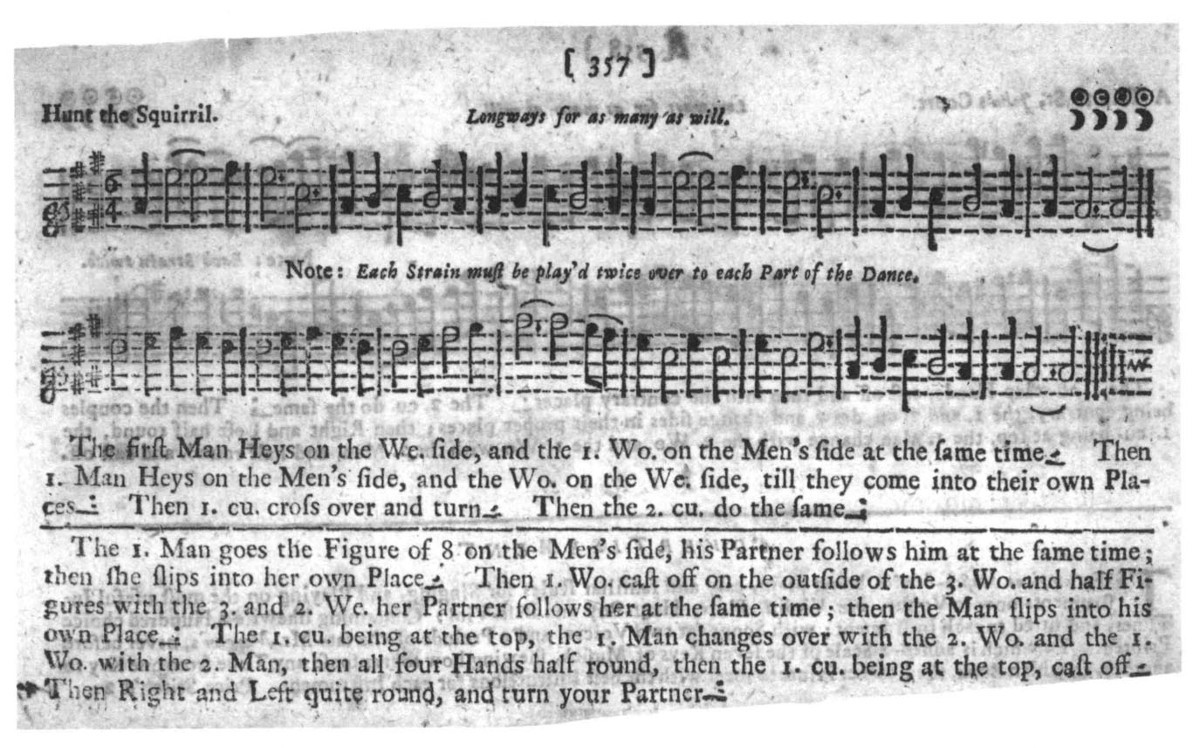
Fig. 42. Page 357 of The Dancing Master, 18th ed., vol. i (London: W. Pearson, [after 1728]).
hunt the squirrel
The dance and melody of “Hunt the squirrel”31 appeared in Walsh, Country Dancing Master (1718), page 16, and in The Dancing Master, volume i, 18th edition (London, [after 1728]) (fig. 42). In North American manuscripts of the 1780s and 1790s such as those of Cushing Eells (fig. 43) and Clement Weeks (fig. 44) the tune and dance are found in nearly exactly the same form as the earlier English edition, indicating another direct tie between English and American sources.
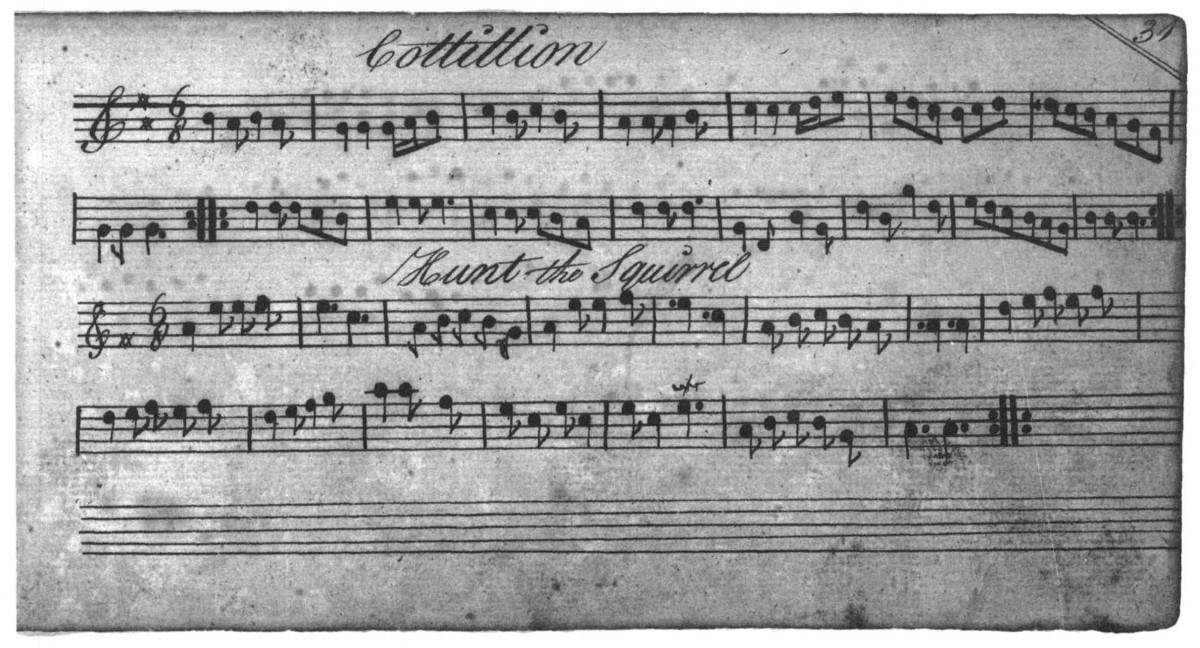
Fig. 43. Page 31 of Cushing Eells’ German flute ms (Norwich, Conn., 1789).32
Fig. 44. Pages 12–13 of Clement Weeks’ dance ms (Greenland, N.H., 1783).33
Fig. 45. Page 24 of Entire New and Compleat Instructions for the Fife (London: John Preston, [ca. 1795]).
Hunt the Squirrel.
1st. Cou. haze on opposite / Sides & then on you own side  & foot it
& foot it  Cross over / 1 Cou
Cross over / 1 Cou  The 1st. cou. cross over / them.
The 1st. cou. cross over / them.  The Gentleman hunts / the Lady upon his Side
The Gentleman hunts / the Lady upon his Side  the / Lady on hers,
the / Lady on hers,  Cross over 1 Cou,
Cross over 1 Cou,  / Right & left at Top.
/ Right & left at Top.
irish wash woman
The antecedent of this still popular tune was associated with the dance in England as early as the sixteenth century when it was known as “Dargason” or “Sedany.” “Dargason” was included in The English Dancing Master (London: John Playford, 1651), page 71. Another early tune which is essentially the same melody is “Country courtship,” a song which was first entered at Stationers’ Hall in 1688.34
A variant of the modern version of the tune appeared as air 13 in Samuel Arnold’s stage piece The Surrender of Calais which was first performed in London on July 31, 1791. Sung by the Irish soldier O’Carrol, the piece became known as “Corporal Casey.”
O’Carrol: When I was at home I was merry and frisky
My Dad kept a pig and my mother sold whiskey
My Uncle was rich but would never be easy
Til I was enlisted by Corporal Casey
Oh, rub a dub, row de dow Corporal Casey
My dear little Sheelah I thought would run crazy
Oh when I trudged away with tough Corporal Casey
As “Corporal Casey” the tune appeared in Instructions for the Fife (London, [ca. 1795]) (fig. 45).
At the same time the title “Irish Wash Woman”35 appeared in A Collection of Contra Dances (Stockbridge, [Massachusetts], 1792) (fig. 46) and an unidentified flute player from Massachusetts wrote out the tune in 1795 (fig. 47). Both the title “The Irish Wash Woman” and its tune as they are known today became popular very quickly. They appeared in many English and American music publications as well as in manuscript collections of tunes and dances.36 The dance which Nancy Shepley of Pepperell, Massachusetts, included in her collection of about 1795 is identical to the printed Stockbridge, Massachusetts, version, and very similar to “Fisher’s Hornpipe” (see fig. 29). In his Connecticut manuscript dated 1793, Asa Willcox gives quite a different version of the “Irish Wash Woman” dance (fig. 48). A third set of figures to this same tune can be found in the Gentleman and Lady’s Companion (Norwich, [Connecticut], 1798).
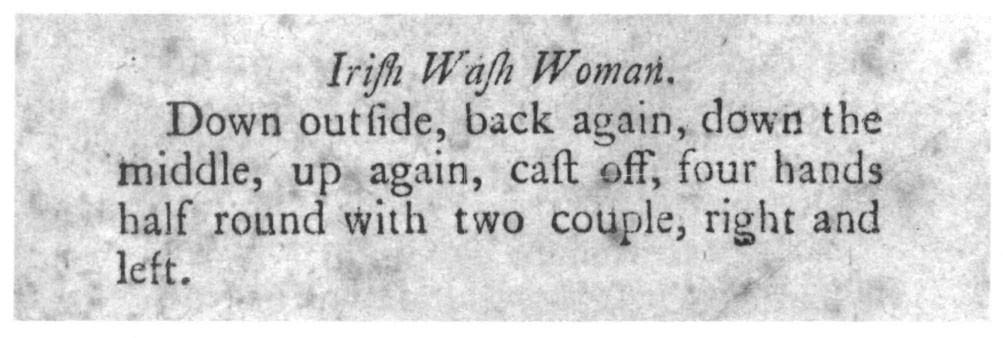
Fig. 46. Page 9 of A Collection of Contra Dances (Stockbridge, [Mass., 1792]).
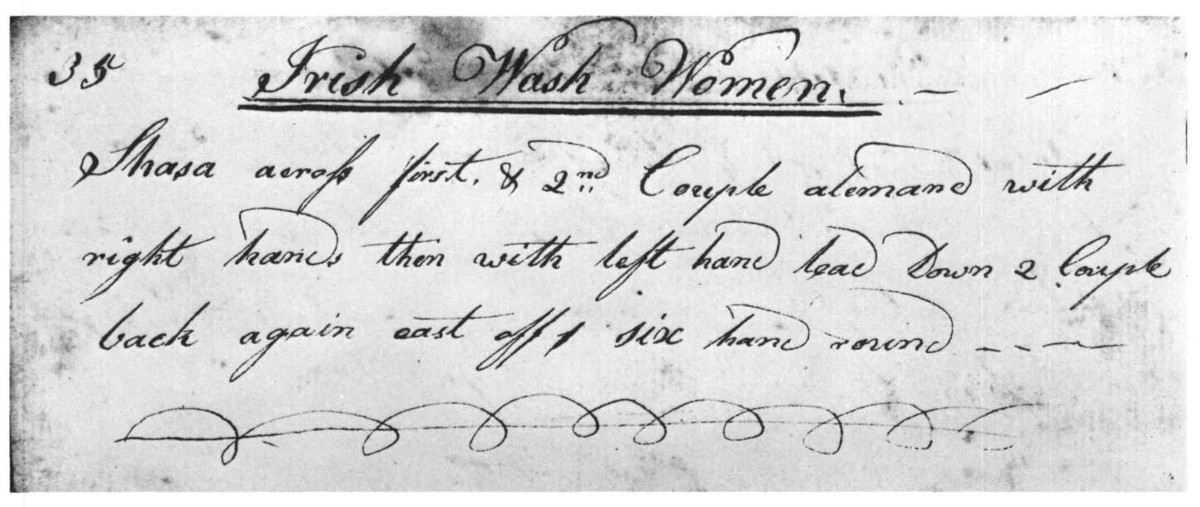
Fig. 48. Number 35 of Asa Willcox’s dance ms (Hartford County, Conn., 1793).
love in a village
The title of this instrumental melody may be derived from the popular opera of the same name by T. A. Arne and Isaac Bickerstaffe (London, 1762). The title appeared in Thompson, 200 Country Dances, volume ii (London, 1765), page 74, but the tune and dance are unlike those known by the same title in North America.
The tune called “Love in a village” which appeared in Henry Beck’s American manuscript collection of tunes (fig. 49) is actually an English dance tune which was called “New Bath whim” in Twenty Four Country Dances for the Year 1765 (London: John Johnson, [1765]) and “Trip to Bedford House” in Twenty Four Country Dances for the Year 1766 (London: R. Bride, [1766]), page 16.
The dance as Nancy Shepley copied it (fig. 50) appeared also in Asa Willcox’s manuscript. A different dance of the same title appeared on page 21 of the Gentleman & Lady’s Companion (Norwich, [Connecticut], 1798):
No. lxxviii “Love in a Village” Four hands across, half way round and back, 1st and 3d couples draw, lead down two couple, cast up one, right and left at top.
maid of the mill
As a topic “The Maid of [or in] the Mill” appeared frequently in the seventeenth and eighteenth centuries. As early as 1647 The Maid in the Mill, a play by Francis Beaumont and John Fletcher, was performed in London.37 A country dance of the same title appeared in Playford’s Dancing Master in 1698 and in successive editions as well as in Walsh’s Country Dancing Master (1718), page 45. Oswald published a song on the theme in the Caledonian Pocket Companion, volume vii (London, [ca. 1750]), page 27, the tune of which was reprinted in Johnson’s Scots Musical Museum, volume v (Edinburg, 1796) page 534. An entirely different song entitled “The Maid of the mill” appeared in 1767 in the Universal Magazine, volume xli (1767), page 376.
When Nancy Shepley wrote out the figures for a country dance she had learned in Pepperell, Massachusetts, in about 1794, it was none of these melodies that she knew, nor was it from Samuel Arnold’s opera of 1765 on the same theme. It was a new song from Rosina (London, 1782) by William Shield that became the popular and long-lived dance tune “Maid of the mill.”38

Fig. 50. Page 2r of Nancy Shepley’s dance ms (Pepperell, Mass., ca. 1795).
The title was derived from the last line of the first verse of the duet beginning “I’ve kiss’d and I’ve prattled with fifty fair maids,” no. 7 in the popular opera. The text, varying only slightly from the published version, was copied in 1784 by John Cabot, a student at Harvard College:
The Words to The Maid of the Mill
[William] I’ve kiss’d and I’ve prattled with fifty fair maids
And changed them as oft do you see.
But of all the gay lasses that sport on the green,
The Maid of the Mill for me.
[Phoebe] There are fifty young men who have told me fine tales,
And call’d me the fairest she,
But of all the gay lasses [sic] that sport on the green,
Young Harrys the lad for me.
[William] Her eyes are as black as the sloe in the hedge,
And her cheeks are like blossoms in May,
Her teeth are as white as the new shorn sheep,
Her breath is the new made hay.
[Phoebe] He’s tall and he’s straight as the poplar tree,
And his cheeks are as fresh as the rose,
He looks like a Squire of high degree,
When dress’d in his Sunday clothes.
Cambridge [Massachusetts] November 12th 1784
J. Cabot39
As with many other hit tunes from the London stage, the song had quickly crossed the Atlantic and was available to musicians to copy. Cabot included the tune also in his collection as did Cushing Eells, a flute student in Norwich, Connecticut (fig. 51). Eells’ version is almost identical to a version of the music preserved mechanically by Daniel Burnap on two chime clocks made at the same time in East Windsor, Connecticut. One of these is at the Wadsworth Atheneum (fig. 52) and the other at the Connecticut Historical Society. A third clock with similar tunes is in the collection of Mrs. Henry Flynt (fig. 53).40
“Maid of the Mill” does not appear frequently in American dance sources. The version Nancy Shepley included on page 4v of her 1794 Massachusetts manuscript was probably copied from a published collection of dances from England:
The Maid of the Mill
First cop. set to 2nd Lady & 3 hands / quite round, same to 2d gent. Lead / down the middle, up again and cast / off right & left at top.
nancy dawson
Nancy Dawson (ca. 1730–1767) was a dancer of great popularity in London during the 1760s. She rose to fame dancing a solo in the revived production of The Beggar’s Opera in 1759 and was immediately celebrated in popular song and country dance.
The tune later called “Nancy Dawson” was an old country dance melody which can be found in MWA, 200 Country Dances (ca. 1740), page 55, there entitled “Piss upon the grass.” A song praising Nancy Dawson was set to this tune (fig. 54) and quickly the melody became a permanent part of the popular song literature. It has survived into the present day as the nursery rhyme “Here we go ’round the mulberry bush,” and as the Christmas carol “I saw three ships come sailing in.”
Fig. 52. Chime clock and dial, 1785–1800, made and owned by Daniel Burnap, Earl Windsor, Conn. (1759–1838).
William Chappell stated that “Nancy Dawson” was printed in many collections as a country dance.41 As an example, he cites a French collection (of ca. 1785) in which the tune appeared as a dance with a different title, the “Sixieme Anglaise de la Reine.”42 In America the tune “Nancy Dawson” appeared in a number of manuscripts including the fife manuscript of Giles Gibbs made in East Windsor, Ellington Parish, Connecticut, in 1777.
Clement Weeks copied “Nancy Dawson” into his collection of country dances in 1783 (fig. 55). At the same time he copied two other sets of figures, “Flowers of Edinburgh” and “Ladies Breast Knot.” Both titles appeared earlier in English dance collections and both tunes were included in Giles Gibbs’ manuscript.
over the hills
This long popular melody first appeared as a country dance in The Dancing Master, volume 2, 2nd edition (London: Printed by W . . . , Church, 1714). It reappeared in Walsh, Country Dancing Master, book ii (1719), page 74. As a song it was frequently printed throughout the eighteenth century and was included in John Gay’s Beggar’s Opera (London, 1729), air 16. Andrew Barton used “Over the hills” as the melody for air 8 in his ballad opera The Disappointment (New York, 1767).
Clement Weeks included “Over the Hills” in his New Hampshire manuscript collection of country dances in 1783 (see fig. 15):
Over the Hills
Two upper Cou. change places,  / back again & foot it
/ back again & foot it  Cross over / one Cou
Cross over / one Cou  & right & left.43
& right & left.43
This dance is considerably less complex than the early eighteenth-century dance to the same tune, and it reappeared in the English publication Twenty Four Country Dances for the Year 1795 (London, T. Dodd, [1795]), page 5.
In 1786 Henry Beck copied the tune into his American manuscript in the form which had remained almost unchanged throughout the eighteenth century and is still popular in dance literature today (fig. 56).
rural felicity
This melody too has remained popular in the country dance literature from the eighteenth century to the present. The title, “Rural Felicity,” is derived from an internal line of the song “Come haste to the wedding” (fig. 57), and it is by the title of that song, “Haste to the Wedding” or simply “Haste,” that it was best known after 1800 (fig. 58). The song first appeared in The Elopement, a pantomime staged in London in 1767. The author and composer of the incidental music are unknown, although T. Giordani’s overture to this popular entertainment was published in London in 1768.
A country dance entitled “Rural Felicity” appeared in England with this tune in Thompson, 200 Country Dances, volume iii (1773), page 96, but Clement Weeks included an entirely different set of figures to this popular title in his manuscript.
Rural Felicity
Turn right hands with your / partner & cast off,  turn left / hands & cast back again,
turn left / hands & cast back again,  hands 4. with 2d. Cou.
hands 4. with 2d. Cou.  Cross over / 2 Cou. & lead up 1 Cou.
Cross over / 2 Cou. & lead up 1 Cou.  set Corners,
set Corners,  / lead out at the Sides.44
/ lead out at the Sides.44
Yet another dance version of “Rural Felicity” appeared in the Gentleman & Lady’s Companion (Norwich, [Connecticut], 1798), page 15.
saint patrick’s day in the morning
This tune is first found printed with a country dance in Rutherford, 200 Country Dances, volume i (1756), page 1. It was popular also as a song and was used as the tune for air 35, “A plague of these wenches,” in the opera Love in a Village by T. A. Arne and I. Bickerstaffe (London, 1762). Giles Gibbs included “St. Patrick’s Day in the morning” in his Connecticut fife manuscript of 1777 (fig. 59) while Clement Weeks wrote out the figures for a country dance to the tune in his collection of 1783:
St. Patrick’s Day in the Morn
1st Gentleman turn with the / 3d. Lady,  the Lady the Same / with the 3d. Gentleman
the Lady the Same / with the 3d. Gentleman  Cross / hands with 1st. Cou. cross over one / Cou. & right & left at Top.–45
Cross / hands with 1st. Cou. cross over one / Cou. & right & left at Top.–45
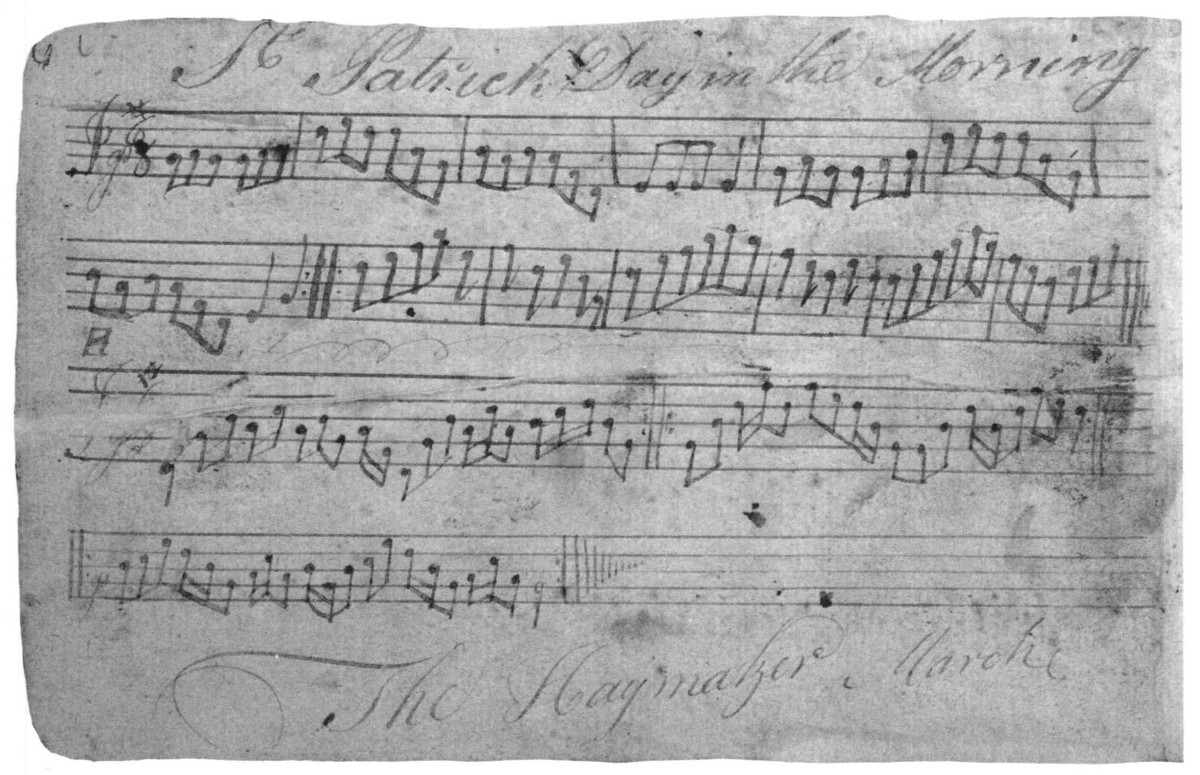
Fig. 59. Page 4v of Giles Gibbs’ fife ms (East Windsor, Conn., 1777).
successful campaign
The popular and well-known country dance, “Successful Campaign,” was reported to have been danced in 1780 at a ball given in Newport, Rhode Island, for George Washington and his staff.46 “Successfull campain or Bath frollick” first appeared in the London imprint Twenty-Four Country Dances for the Year 1769 (fig. 60), and was reprinted in Thompson, 200 Country Dances, volume iii (1773).
So popular was the tune that almost every manuscript collection after 1769 included it. Henry Beck’s “Successful campaign” (fig. 61) is very similar to the earlier printed tune. In his 1793 Connecticut manuscript Asa Willcox included a different set of figures from the earlier English publications which first contained directions with this title. Willcox’s dance instructions are identical to the figures for “Successful Campaign” as found in several other New England manuscripts and in printed collections such as the Gentleman & Lady’s Companion (Norwich, [Connecticut], 1798), page 1, and the Select Collection (Otsego, [New York]: H. & E. Phinney, 1808), page 56 (fig. 62).
sukey bids me
This title can be found with a similar dance in the English publications: Rutherford, 200 Country Dances (1756), page 25, and in Johnson, 200 Country Dances (1751), page 52. It appears in America in Clement Weeks’ New Hampshire dance manuscript collection on page 20 as “Suckey Bids Me” (fig. 36) and in the Walpole, New Hampshire, A Collection of Contra Dances, printed in 1799 (fig. 63).
Two transcriptions of a second country dance by this title also occur in the Clement Weeks manuscript. The first is included in the section indicated as “taken from D. Smith’s Collection”:
Fig. 61. Page 13 of Henry Beck’s German flute ms (American, 1786).47
Succa bids me
3 hands round the man’s side  / 3 hands round the wo’s side
/ 3 hands round the wo’s side  Cross / over 2 Cou
Cross / over 2 Cou  right & left.
right & left.  48
48
For the second, see figure 39.
“Sukey bids me” appeared also in Thompson, 200 Country Dances, volume i (1758), page 95, but with an entirely different dance to the same tune. This same melody with the variant spelling “Sakey bids me” is included in Giles Gibbs’ 1777 Connecticut collection for the fife (fig. 64).
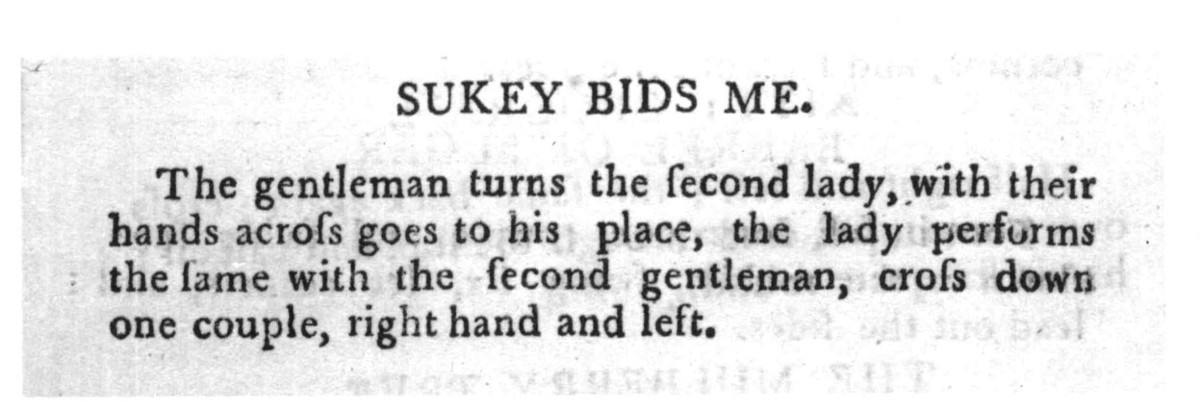
Fig. 63. Page 7 of A Collection of Contra Dances (Walpole, [N.H., 1799]).
sweet richard
“Sweet Richard” first appeared in Johnson’s Wright’s Collection (ca. 1742) (fig. 65). A second dance to a variant of this tune was contained in Twenty Four Country Dances for the Year 1771 (London: Chas. & Saml Thompson, [1771]). page 73. A third version of the tune, this time copied in 1782 by Aaron Thompson, fife major in the New Jersey line and native of Connecticut, contained a third set of dance figures (fig. 66). The Thompson dance reappeared later in the United States in the Select Collection (Otsego, [New York], 1808) (see fig. 62). The same title to yet a fourth tune and dance appeared in Preston’s Twenty-Four Country Dances for the Year 1797 (London: Preston & Son, [1797]), page 140.49
Fig. 65. Page 16 of Wright’s Compleat Collection of Celebrated Country Dances, vol. i (London, [ca. 1742]).
Checklist of Eighteenth-Century Dance Manuscripts in America
“Early American Dances.” Commonplace book containing figures for 20 country dances in manuscript, ca. 1795. Boston Athenæum.
Frobischer, C[arolyn] R[achel], Music copybook filled with 42 pieces in manuscript arranged for harpsichord, most with words, 14 with figures for country dances. Montreal, 1793. National Library, Ottawa (neg. phot.).
Litten, William. Manuscript collection of fiddle tunes and figures for country dances, ca. 1800–1802. Duke County Historical Society, Edgartown, Massachusetts.
Mason, G. C. Reminiscences of Newport (Newport, R.I.: C. E. Hammett, Jr., 1884). On pp. 80–81 Mason describes a manuscript collection containing the figures for 35 country dances. He lists 21 titles and includes the figures for 7 of these. From these it is clear that the collection dates from the 1790–1800 period. Unlocated.
Merrill, Joseph. “New Country Dances.” Commonplace book containing manuscript copy of Thompson’s 24 Country Dances for the Year 1793 (London: Samuel, Ann & Peter Thompson, 1793), 1793. Pejepscot (Maine) Historical Society.
Moore, Henry. Commonplace book containing figures for 37 country dances in manuscript, ca. 1795. Delaware State Library, Ridgeley Collection.
Mussey, Lucy. Commonplace book containing figures for 42 country dances in manuscript. Plainfield, Vermont, 1790. Dance entries date ca. 1794. Private collection.
Playing cards containing manuscript directions for five country dances. Boston, ca. 1781. Unlocated. Reference: Catherine Perry Hargrave, “The Playing Cards of Puritan New England,” Old-Time New England, xviii (1928), 166–181.
Rainsdorp, Walter. Commonplace book, holograph, consisting of a collection of 80 country dances with descriptions of the figures and the tunes. London, 1747. Yale University, Beinecke Library.
Shepley, Nancy. “Nancy Shepley’s Book” containing the figures for 55 country dances in manuscript. Pepperell, Massachusetts, ca. 1794. American Antiquarian Society.
Shipton Family Collection. Commonplace book containing the figures for 14 country dances in manuscript, ca. 1795. Rhode Island Historical Society.
“Square Dances.” Commonplace book containing the figures for 54 country dances in manuscript, ca. 1795. New Hampshire Historical Society.
Thompson, Aaron, 1759–1832. Commonplace book containing 99 tunes for the fife, 5 with figures for country dances; 5 song texts; accounts, diary entries, and penmanship exercises in manuscript. New Jersey, 1777–1782. Yale University.
“Twenty Four Country Dances for the Year 1782.” Commonplace book containing a manuscript copy of Twenty Four Country Dances for the Year 1782 (London: T. Skillern, 1782). Complete except for the substitution of “Windsor Terrace,” “The Dogger Bank,” “Dartford Camp,” and “The Harriot” for “Garret Election,” “The Great Devil,” “Margate Whim,” and “Rochester Rakes.” New England Historical Genealogical Society.
Weeks, Clement, 1750–1829. “Figures of Contra Dances. A Collection of [43 country] dances belonging to Clement Weeks.” Manuscript. Greenland, New Hampshire, 1783. American Antiquarian Society. See Old-Time New England xvlii (August 1957), 108–111.
Willcox, Asa, b. 1756. “Asa Willcxs [sic] book of Figures.” Commonplace book containing the figures for 3 cotillons and 37 country dances in manuscript. New Hartford, Connecticut, 1793. Newberry Library.
Bibliography of Illustrative Material
Anonymous. Flute book, ms. 1. Manuscript collection of tunes for treble instrument, ca. 1795. Library of Congress (M63 F5 No. 1 Case). (Fig. 47. Page illustrated: 38.)
Beck, Henry. Copybook containing instructions for the German flute copied from The Compleat Tutor for the German Flute (London: Chas. & Samuel Thompson, [1775]); and 317 tunes. Manuscript, American, 1786. Library of Congress. (Figs. 6, 21, 22, 35, 38, 49, 56, 61. Pages illustrated: 7, 12, 13, 38, 44, 53, 55, 60.)
Collection of Contra Dances. Stockbridge, [Massachusetts], 1792. American Antiquarian Society. Evans 46413. (Figs. 46, 63. Pages illustrated: 7, 9.)
Collection of Contra Dances. Walpole, [New Hampshire]: Museum Press, 1799. American Antiquarian Society. Evans 35320. (Fig. 11. Page illustrated: 9.)
“Come Haste to the Wedding” [London, 1768]. Single sheet folio. Marshall Collection, Houghton Library, Harvard University. (Fig. 57.)
Compleat Tutor for the German Flute. London: Jonathan Fentum, [ca. 1766]. Library of Congress. (Fig. 23. Page illustrated: 13.)
Dancing-Master. Vol. i, 18th ed. London: W. Pearson, [after 1728]. American Antiquarian Society. (Fig. 42. Page illustrated: 357.)
Eells, Cushing. Commonplace book containing 72 tunes for German flute and 9 song texts. Manuscript, Norwich, Connecticut, 1789–1790. Connecticut Historical Society. (Figs. 43, 51. Pages illustrated: 31, 49.)
Entire New and Compleat Instructions for the Fife. London: John Preston, [ca. 1795]. Library of Congress. (Fig. 45. Page illustrated: 24.)
Fifer’s Companion, No. 1. Salem, [Massachusetts]: Joshua Cushing, [1805]. Essex Institute. Shaw-Shoemaker 50536. (Fig. 33. Page illustrated: 40.)
Gentleman & Lady’s Companion. Norwich, [Connecticut]: J. Trumbull, 1798. American Antiquarian Society. Evans 48462. (Fig. 25. Page illustrated: 11.)
Gibbs, Giles, Jr. “Giles Gibbs His Book for the Fife” (commonplace book containing 60 tunes for fife). Manuscript, East Windsor, Connecticut, 1777. Connecticut Historical Society. (Figs. 59, 64. Pages illustrated: 4v, 11r.)
Greenwood, John. Commonplace book containing 97 tunes for German flute. Manuscript, 3 hands represented, ca. 1783 with later additions. New-York Historical Society. (Fig. 28. Page illustrated: 50.)
Griffith, John. A Collection of the Newest Country Dances and Cotillions. Providence, [Rhode Island, 1788]. Rhode Island Historical Society. Evans 21122. (Fig. 29. Page illustrated: 6.)
Griffiths, John. A Collection of the Newest Cotillions and Country Dances. Northampton, [Massachusetts, 1794]. Massachusetts Historical Society. Evans 21121. (Figs. 7, 31, 32. Pages illustrated: 3, 7, 9.)
“Nancy Dawson.” [London, ca. 1760]. Single sheet folio. Marshall Collection, Houghton Library, Harvard University. (Fig. 54.)
“Original Black Joke sent from Dublin.” [London, ca. 1720]. Single sheet folio. Marshall Collection, Houghton Library, Harvard University. (Fig. 18.)
[Oswald, James]. “A Favourite Song in the Reprisal.” [London, ca. 1757]. Single sheet folio. Marshall Collection, Houghton Library, Harvard University. (Fig. 14.)
Perkins, Whittier. “A Collection of Dancing Tunes, Marches, St Song Tunes.” Manuscript, Massachusetts, 1790. Columbia University, Division of Special Collections (x780.973/c68). (Fig. 34. Page illustrated: 16.)
Select Collection of the Newest & Most Favorite Country Dances, Waltzes, Reels & Cotillions. Otsego, [New York]: H. & E. Phinney, 1808. American Antiquarian Society. Shaw-Shoemaker 16164. (Figs. 13, 27, 41, 58, 62. Pages illustrated: 16, 24, 24, 56, 64.)
Shepley, Nancy. “Nancy Shepley’s Book” (containing the figures of fifty-five country dances). Manuscript, Pepperell, Massachusetts, ca. 1794. American Antiquarian Society. (Figs. 24, 50. Pages illustrated: 2r, 2v.)
Thompson, Aaron. Commonplace book containing 99 tunes for the fife, 5 with figures for country dances; 5 songs; accounts, journals, and penmanship exercises. Manuscript, New Jersey, 1777–1782. Yale University, Sterling Library, Manuscripts and Archives. (Figs. 5, 66. Pages illustrated: 49, 52.)
Thompson’s Compleat Collection of 200 Favorite Country Dances. Vol. ii. London: Charles and Samuel Thompsons, [1765]. John Carter Brown Library. (Figs. 17, 20, 37. Pages illustrated: 2, 90, 94.)
Thompson’s Compleat Collection of 200 Favorite Country Dances. Vol. iii. London: Charles and Samuel Thompsons, [1773]. Forbes Library, Northampton, Massachusetts. (Fig. 40. Page illustrated: 95.)
Twenty Four Country Dances for the Year 1769. London: C. & S. Thompson, [1769]. Library of Congress. (Figs. 8, 60. Pages illustrated: 50, 52.)
Twenty Four Country Dances for the Year 1788. London: Saml. Ann and Peter Thompson, [1788]. Library of Congress. (Fig. 30. Page illustrated: 1.)
Weeks, Clement. “Figures of Contra Dances. A Collection of [43] dances belonging to Clement Weeks.” Manuscript, Greenland, New Hampshire, 1783. American Antiquarian Society. (Figs. 15, 36, 39, 44, 55. Pages illustrated: 4, 7, 10–11, 12–13, 20.)
Willcox, Asa. “Asa Willcxs [sic] book of Figures.” Manuscript, Hartford County, Connecticut, 1793. Newberry Library. (Figs. 9, 12, 48. Numbers illustrated: 2, 23, 35.)
Wright’s Compleat Collection of Celebrated Country Dances. Vol. i. London: J. Johnson, [ca. 1742]. Essex Institute (lacking cover and prefatory pages but tentatively identified as this book; see fig. 3 for title page from the Vaughn Williams Memorial Library copy, Cecil Sharp House, London). (Figs. 16, 19, 26, 65. Pages illustrated: 15, 16, 24, 49.)

